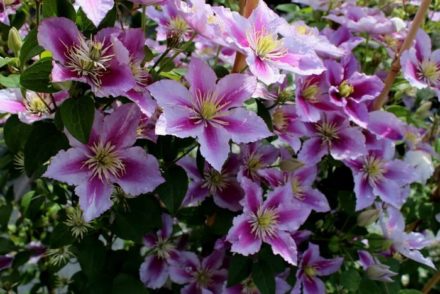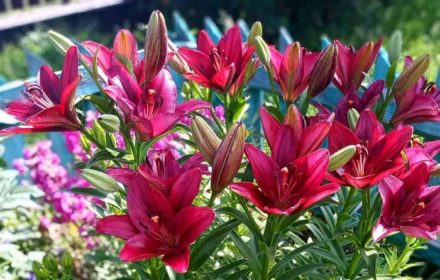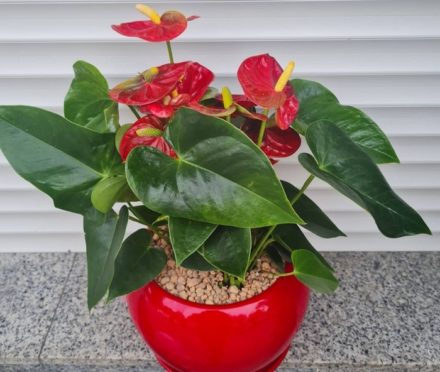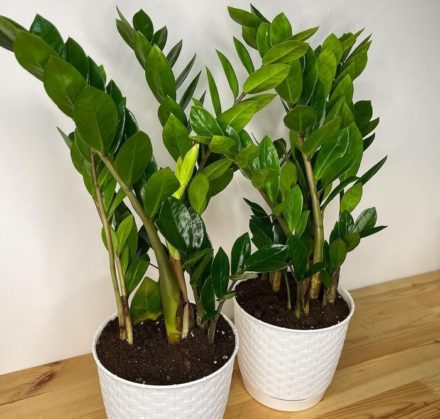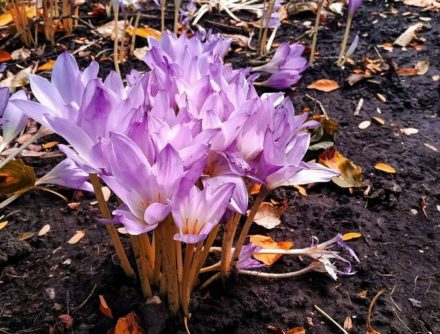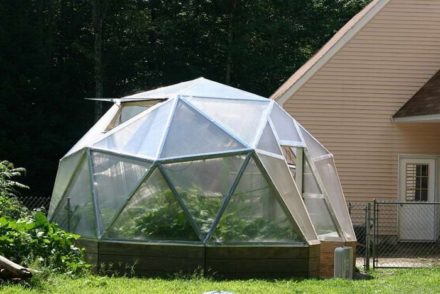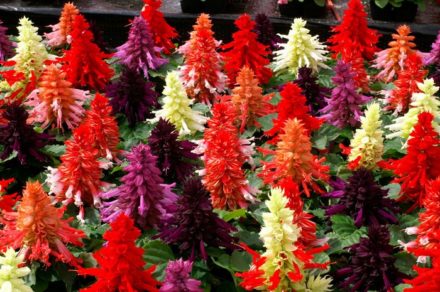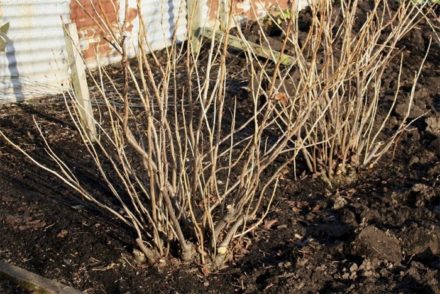Cyclamen is a popular plant for indoor floriculture. It is valued for its compact size and original flowers that smell pleasant. The flower enters the dormant stage if environmental conditions are unfavorable for it. Inexperienced flower growers think that it is dead and throw it away. It is important to know the care recommendations and the vital functions of cyclamen. Then it will delight you with flowering every season.
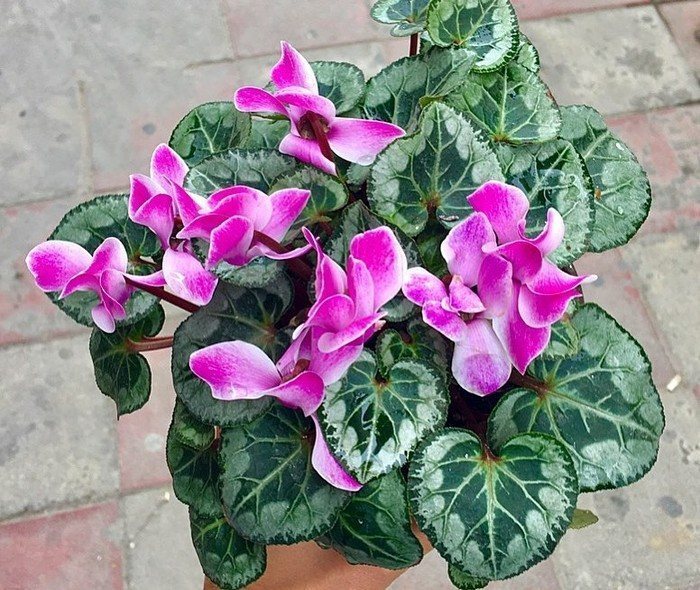
- Botanical description of the plant
- Classification
- Spreading
- Dimensions
- Lifespan and growth
- Other characteristics
- Types of cyclamen
- European (Cyclamen europaeum)
- Persian (Cyclamen persicum)
- Caucasian
- African
- Ivy-leaved
- Cypriot
- Colchis
- Greek
- Lebanese
- Conditions for growing cyclamen at home
- Temperature
- Lighting
- Humidity indicators
- Where to keep
- Cyclamen care
- Priming
- Tara
- Watering
- Spraying
- Fertilizer
- Trimming
- Transfer
- Bloom
- During
- After
- Rest period
- Mistakes in caring for cyclamen
- Reproduction of cyclamen
- Seeds
- Preparation of planting material
- Preparing the soil and pot
- Transplanting into pots
- Children
- Tubers
- Rosettes
- Leaf
- Major pests
- Shchitovka
- Mealybug
- Thrips
- Spider mite
- Cyclamen mite
- Aphid
- Grape weevil
- Frequent cyclamen diseases
- Fusarium wilt
- Wet rot
- Gray rot
- Root rot
- Anthracnose
- Sooty fungus
- Problems during cultivation
- Spots on leaves
- Spots on flowers
- The leaves are turning yellow
- Leaves wither
- Leaves are drying
- The leaves are curling
- The leaves are falling
- The flower sheds its buds
- Spots on tubers and leaf petioles
- Flowers hiding under leaves
- Plaque on buds and flowers
- Scanty flowering
- No flowering
- Useful properties of cyclamen
- Is there any harm
- Signs and superstitions
- Family happiness
- Wealth
- For men
- For women
- Reviews from flower growers
Botanical description of the plant
Cyclamen belongs to the Primrose family. It has a large tuber underground. Heart-shaped, kidney-shaped or ovoid-shaped leaves grow on the surface. Long stalks crown beautiful flowers. The pedicels curl into a spiral when flowering ends. The flower has one pistil and five stamens. Cyclamen fruits are multi-seeded capsules.
Classification
The genus Cyclamen includes several species.
Popular types:
- European;
- Persian;
- Caucasian;
- African;
- ivy-leaved;
- Cypriot;
- Alpine;
- Colchian;
- Greek;
- Balearic;
- Cilician;
- Lebanese;
- small-flowered.
During the summer, most cyclamen species go dormant. The leaves dry out and fall off. The tubers accumulate moisture before flowering, which begins in the fall.
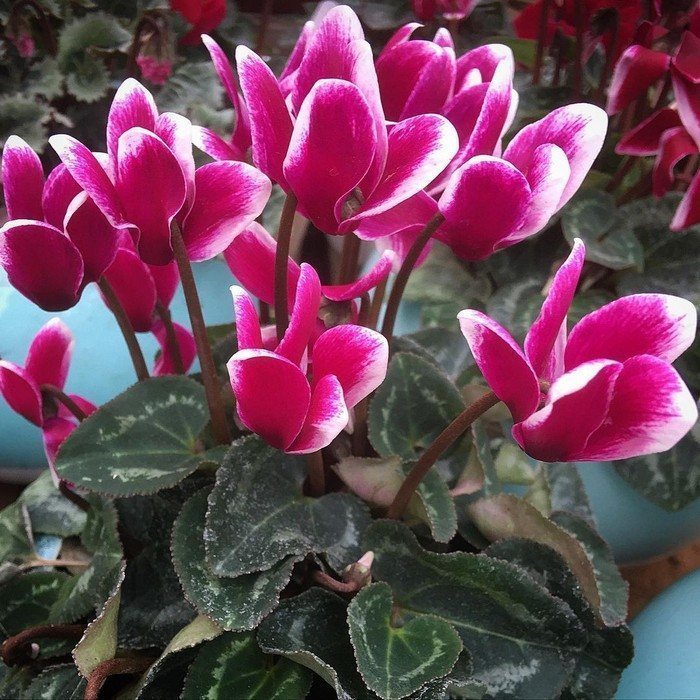
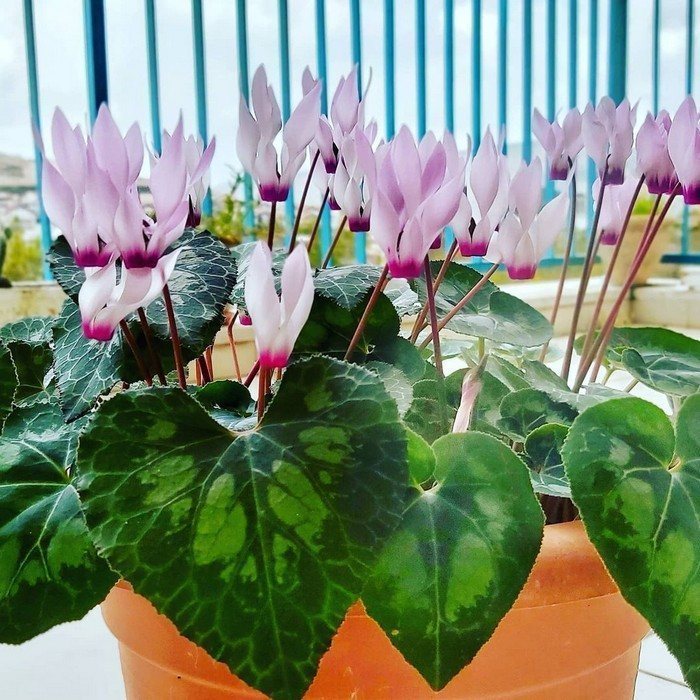
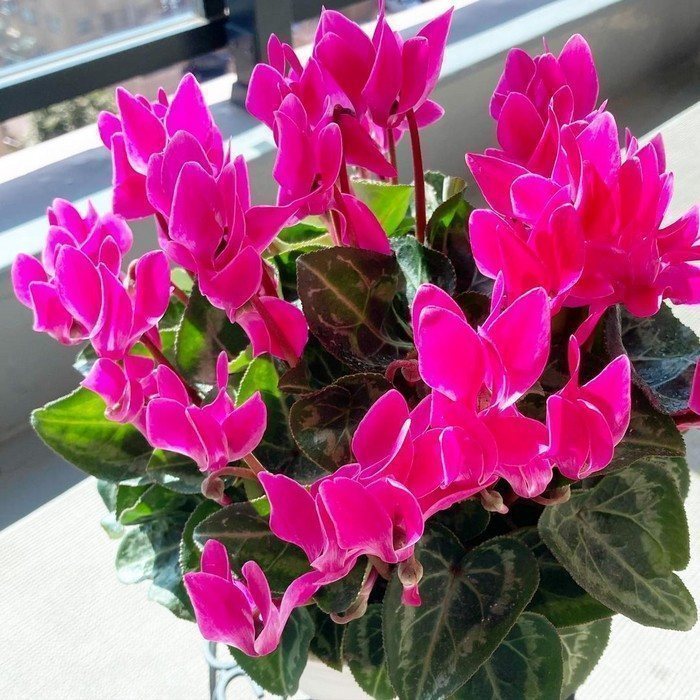
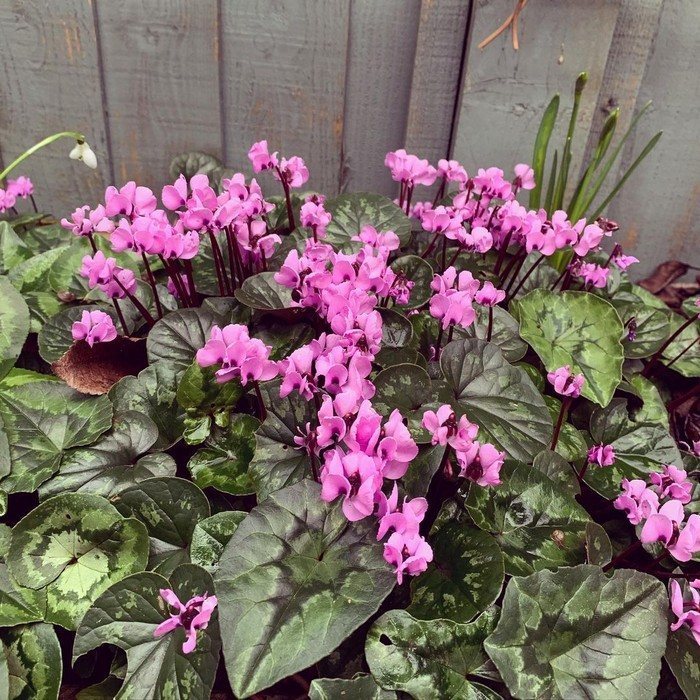
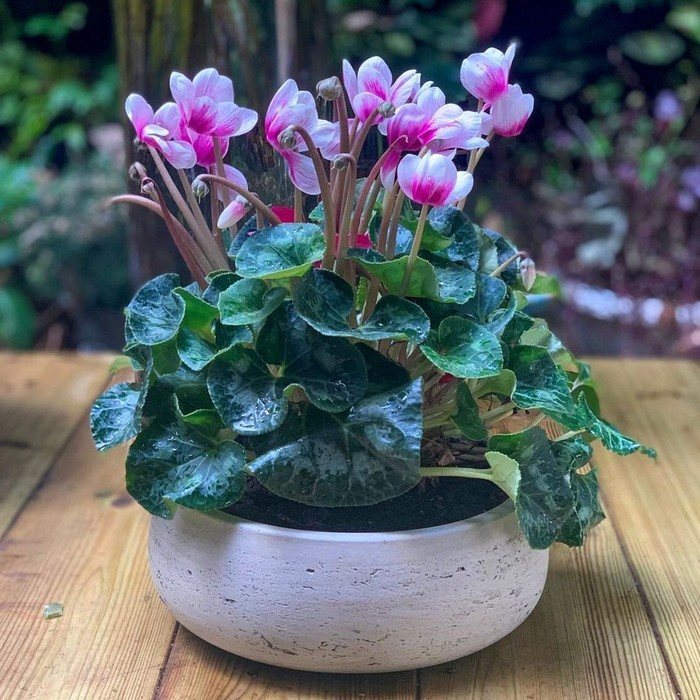
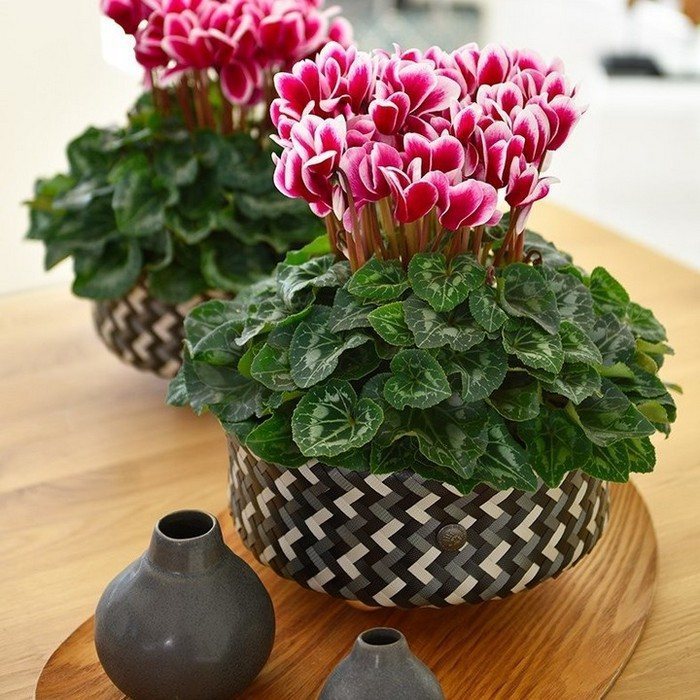

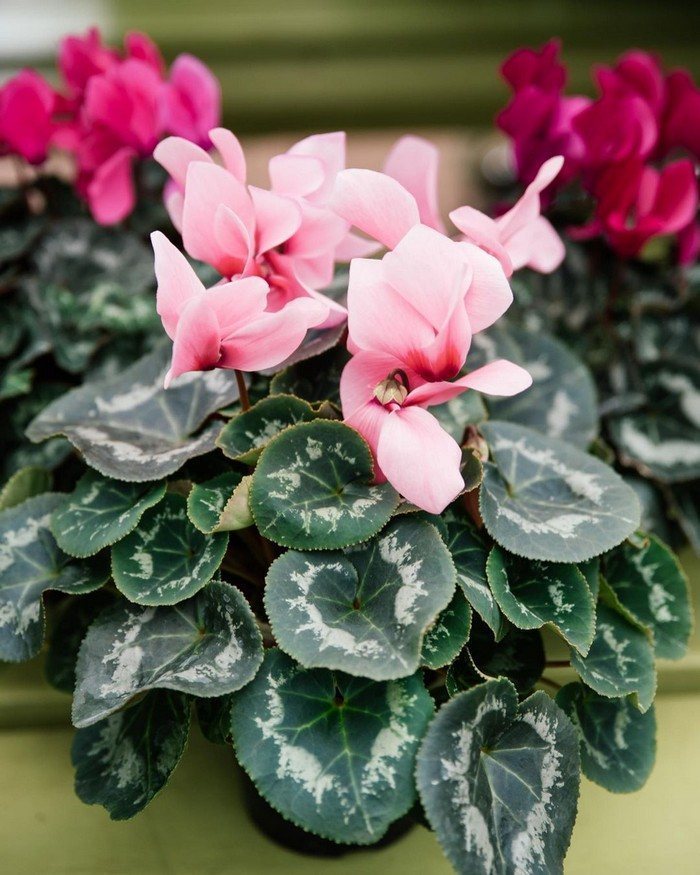
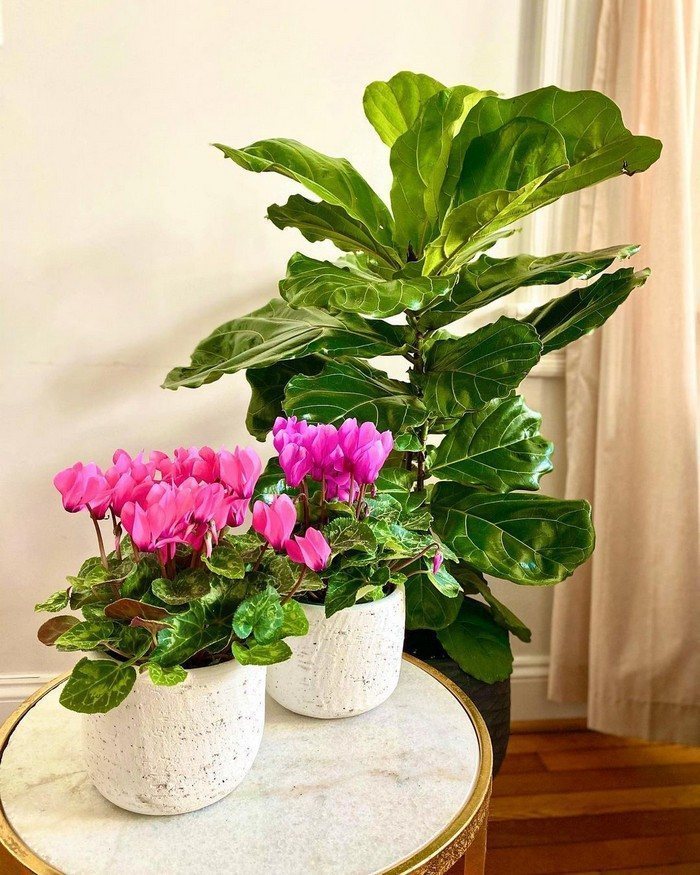
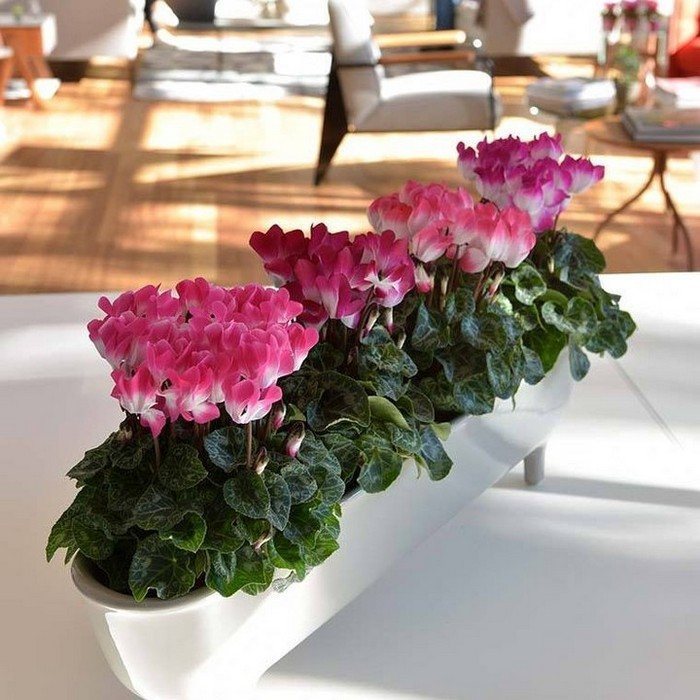
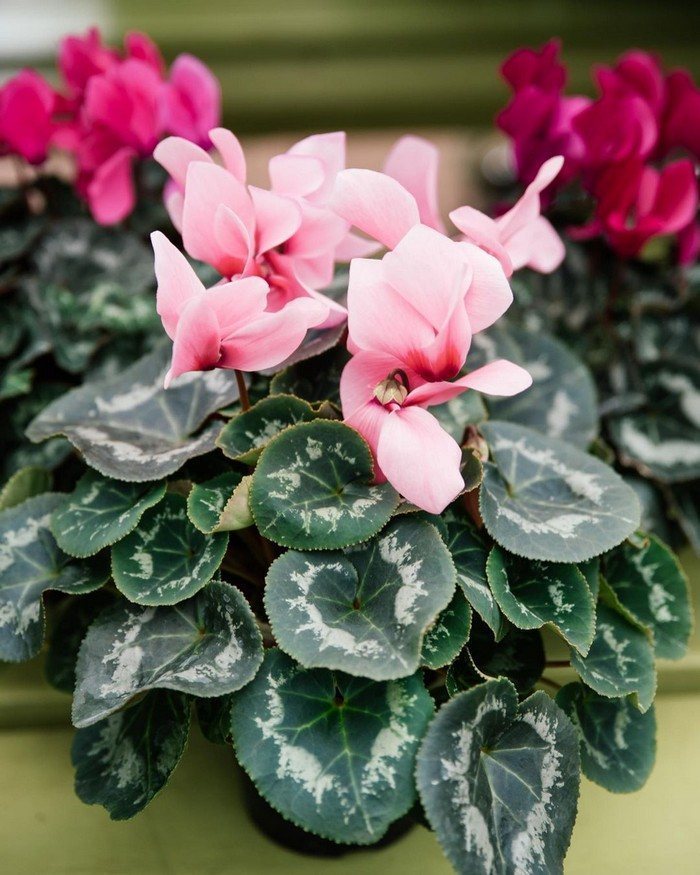
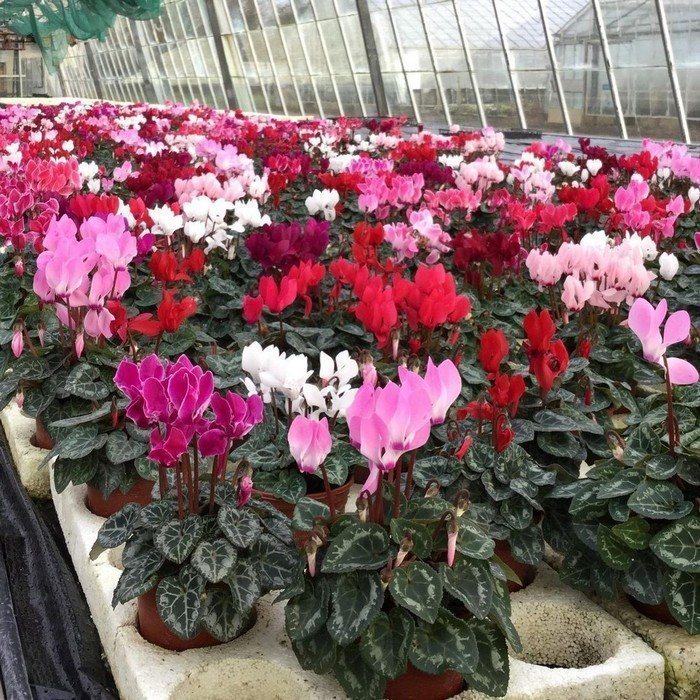
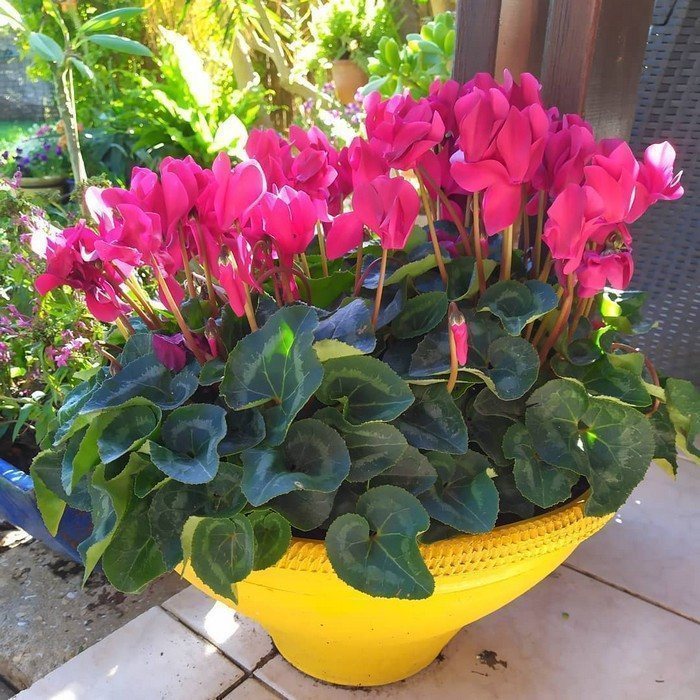
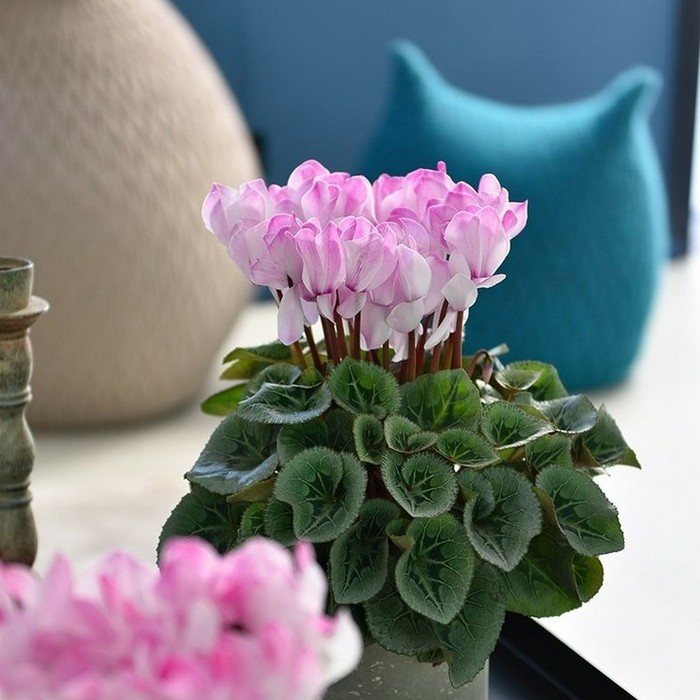
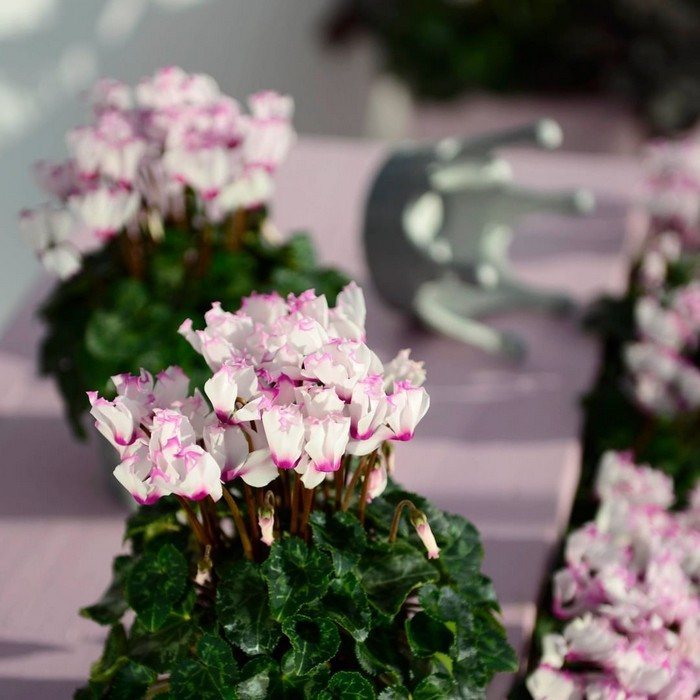
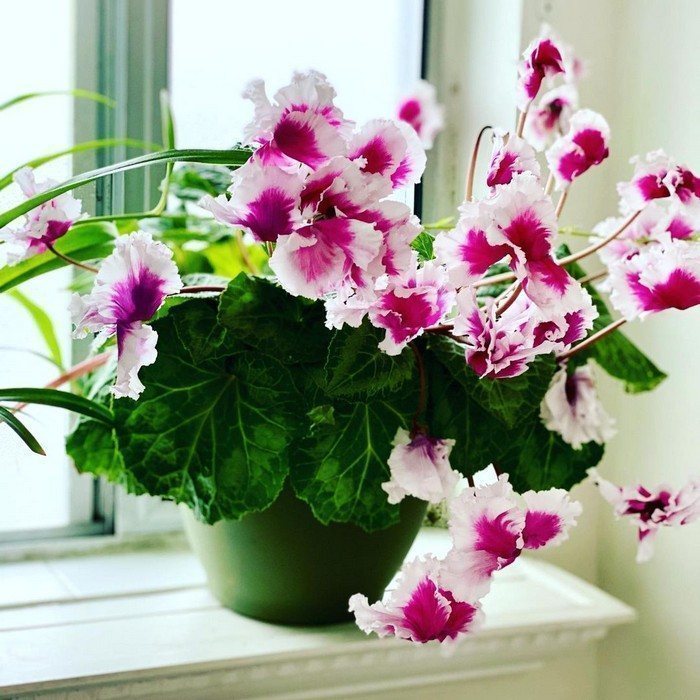
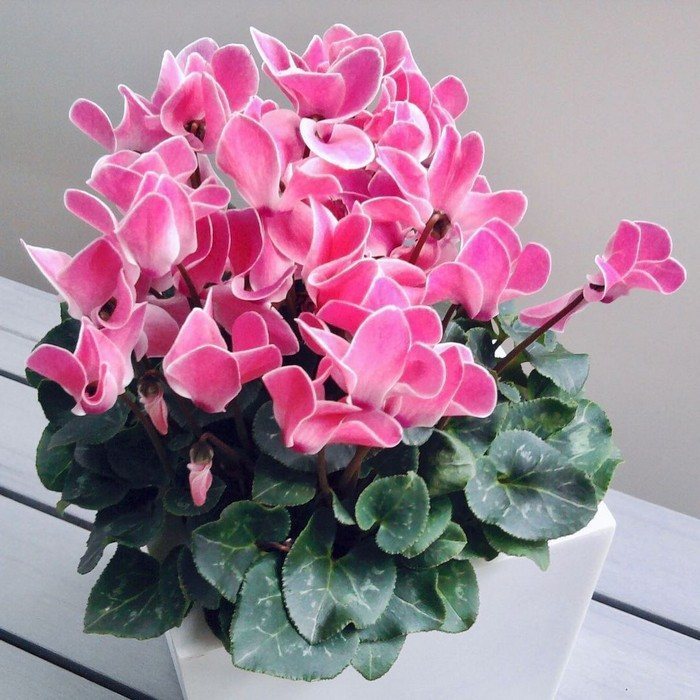

















Spreading
Cyclamen are native to the Mediterranean, Northeast Africa, Asia Minor and Central Europe. In Russia, they are found in the Krasnodar Territory and the Crimean Peninsula.
Dimensions
Cyclamen are divided by height:
- short, about 15 cm high;
- medium height – 20 cm;
- standard – 30 cm.
The tuber reaches 15 cm in diameter. Damage to it leads to the death of the plant. The leaves are large, up to 14 cm in diameter.
Lifespan and growth
The lifespan of cyclamen ranges from 12 to 25 years.In summer, the flower goes into hibernation due to unfavorable conditions for its life. He can't stand the heat. Modern varieties for home floriculture are more heat-resistant.
The life span of the plant is from 28 to 33 weeks. After this, it goes back into the resting phase and prepares for the next cool season.
Other characteristics
Flowering occurs when the temperature drops to +15 degrees. Cyclamen produces from 50 to 70 buds. Although one flower lives for about 10 days, the flowering period lasts several months. It begins in autumn and lasts until spring. After this, the plant sheds its leaves and a dormant period begins for it.
The number of leaves and flowers of a plant depends on the size of its tuber. Flowers of different types of plants have a whole palette of pink and red shades. There are also pure white flowers.
Types of cyclamen
Different types of cyclamen have their own external characteristics, duration of flowering, hibernation period, etc.
European (Cyclamen europaeum)
European cyclamen (blushing) or “alpine violet” grows up to 15 cm. Its habitat is the territories of Southern Europe and the Crimean Peninsula. Does not shed leaves during hibernation. The flowers are about 3 cm in size, white or pink. Dark flowers exude a pleasant, noble aroma more strongly.
Popular varieties:
- “Green Ice” – distinguished by small flowers (about 2cm). The leaves seem to be covered with silvery frost.
- "Silver." Leaves with random silvery lines. There are lilac stains on the pink flower petals.
- "Album". Small plants with white flowers that sit on long stalks.
Cyclamen slows down growth under unfavorable conditions. The above-ground part is brittle and fragile, so you need to be careful when handling.
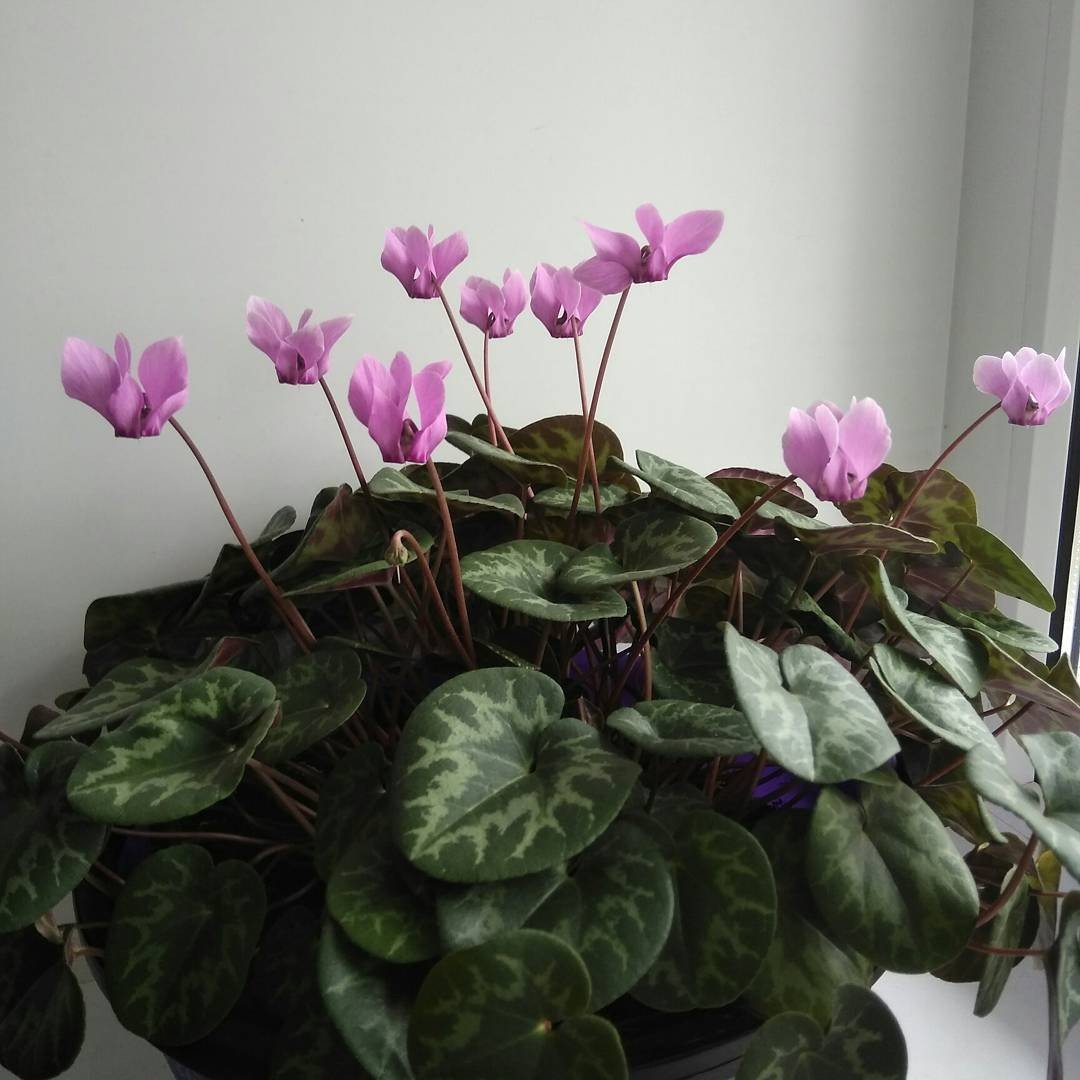
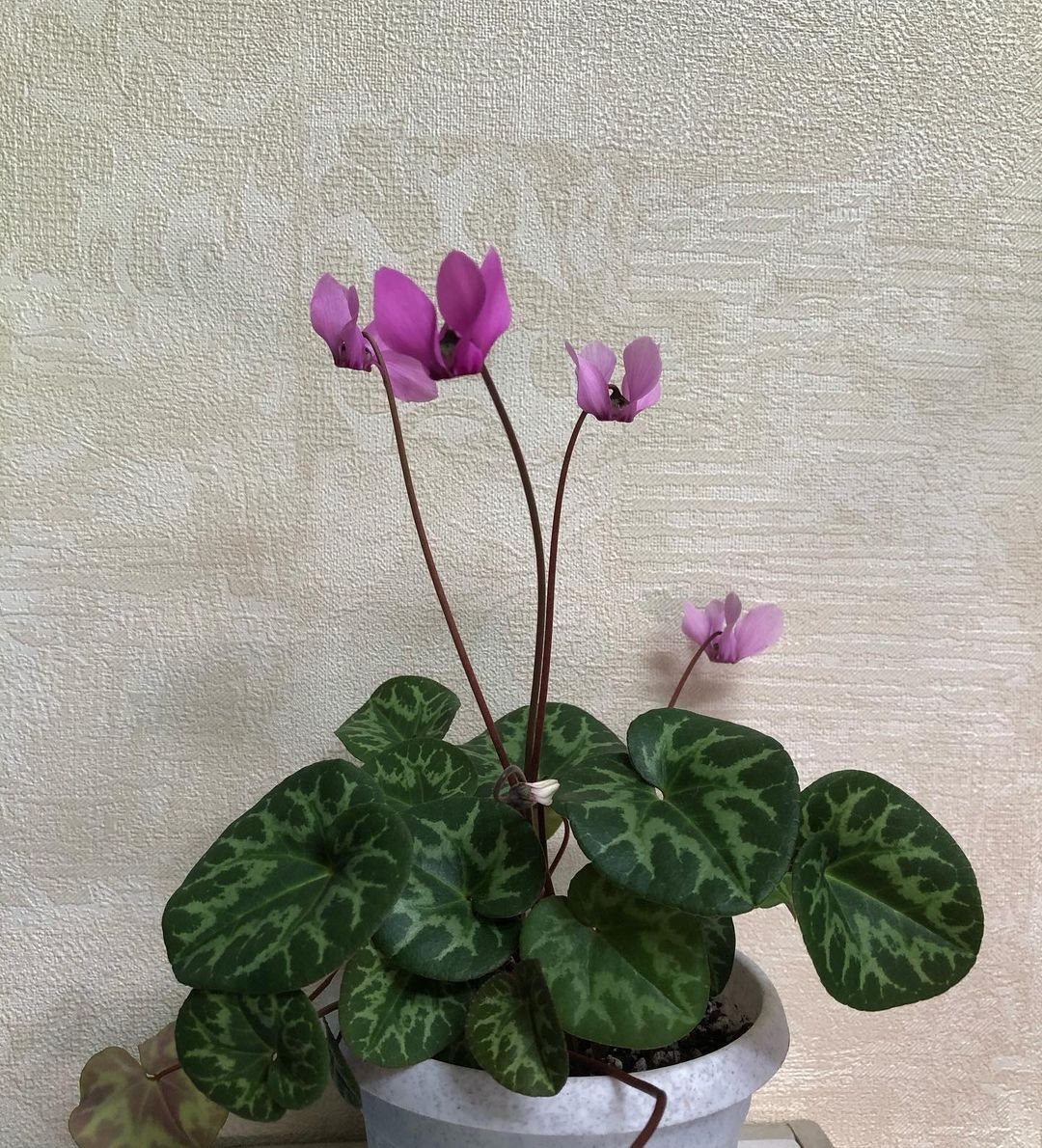

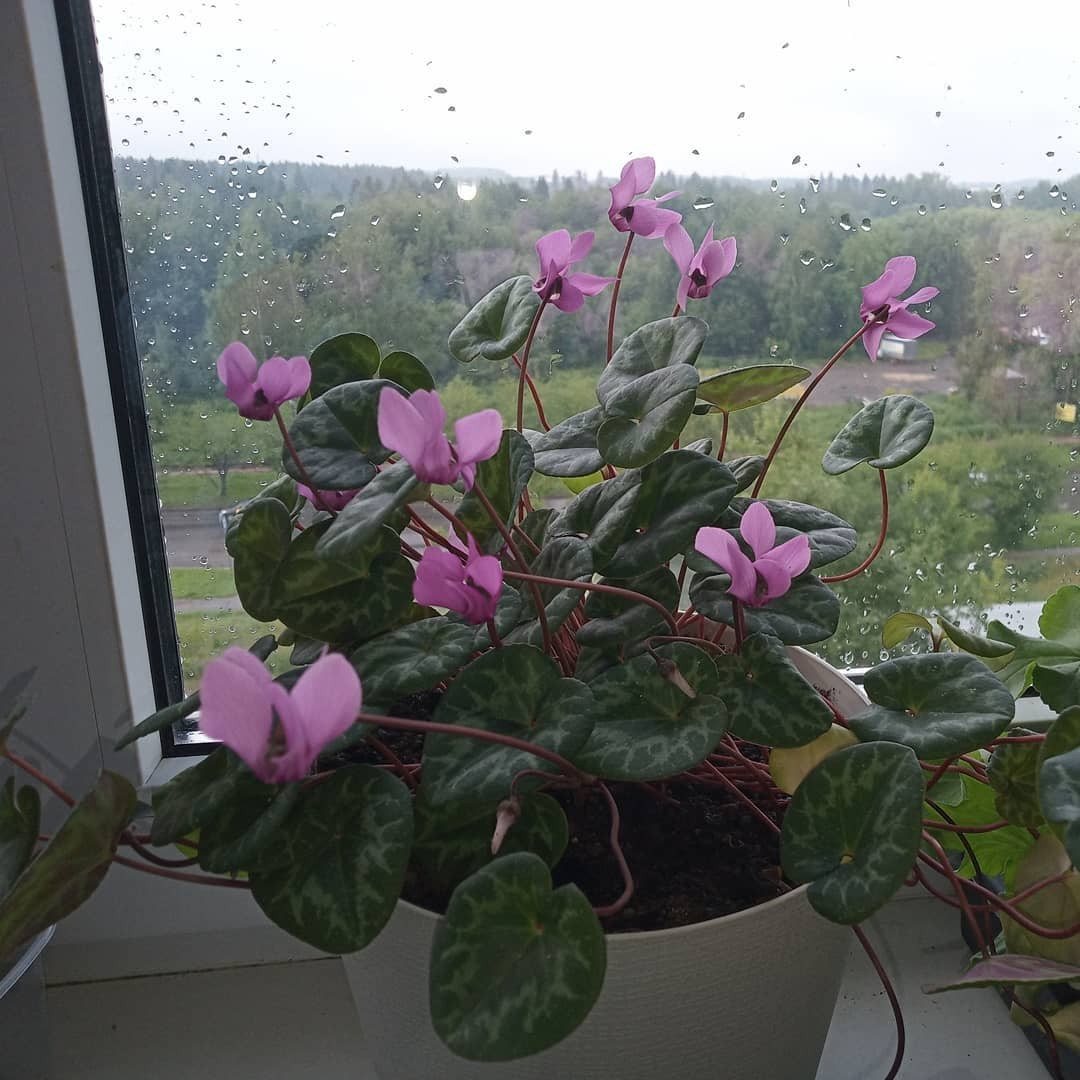
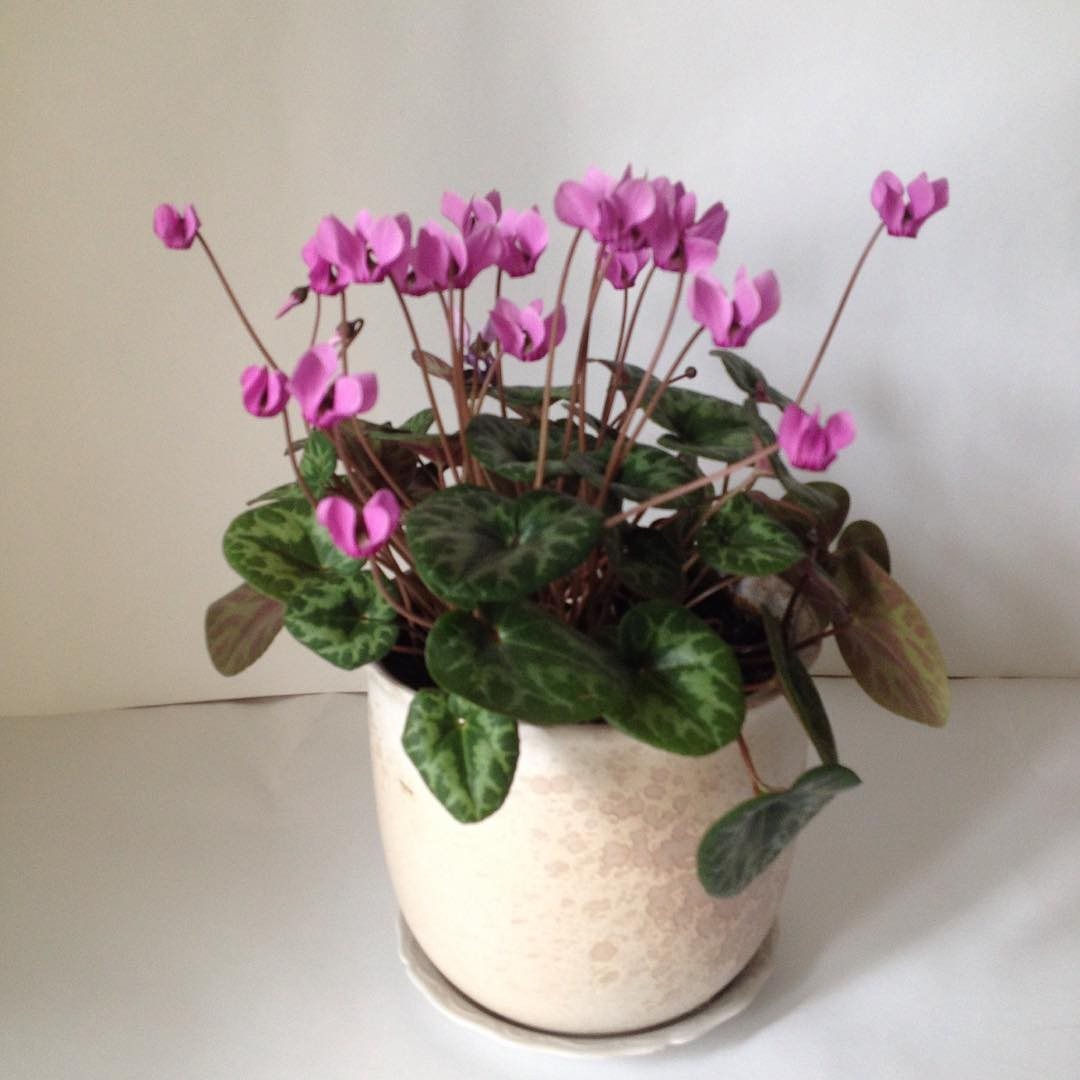





Persian (Cyclamen persicum)
Most often than all other types of cyclamen, it is used as a houseplant. Active selection of varieties began in the 19th century. Most of the plants were bred in England and Holland.
The height of the bush reaches 30 cm. The tuber is flattened. The plant blooms from early winter to late spring. The diameter of the flowers is 5 cm. The color range is crimson or light pink.
Varieties are grouped by height:
- standard – up to 30 cm;
- intermediate height from 20 to 25 cm;
- miniature up to 15 cm.
Popular varieties:
- "Barbarossa". The flowers resemble irises because of the beards on the petals. The most common petal color ranges from light to deep pink.
- "Umbrella" (from the English umbrella - umbrella). The pink flowers resemble open umbrellas.
- "Lulu." A plant of intermediate height with large salmon-red flowers. The petals are fringed at the edges.
- "Large-flowered." Height 20 – 40 cm. Flowers have a classic shape for cyclamens.
- "Rococo". Large flowers of deep pink color. There is a thick fringe along the edges of the petals.
- "Striata". White flowers with purple veins have a pleasant scent. The height of the bush is 15 – 20 cm.
The developed varieties have flowers ranging from white to dark purple. Sometimes the petals are complex in color, with veins. The shape is simple, terry or with fringe.
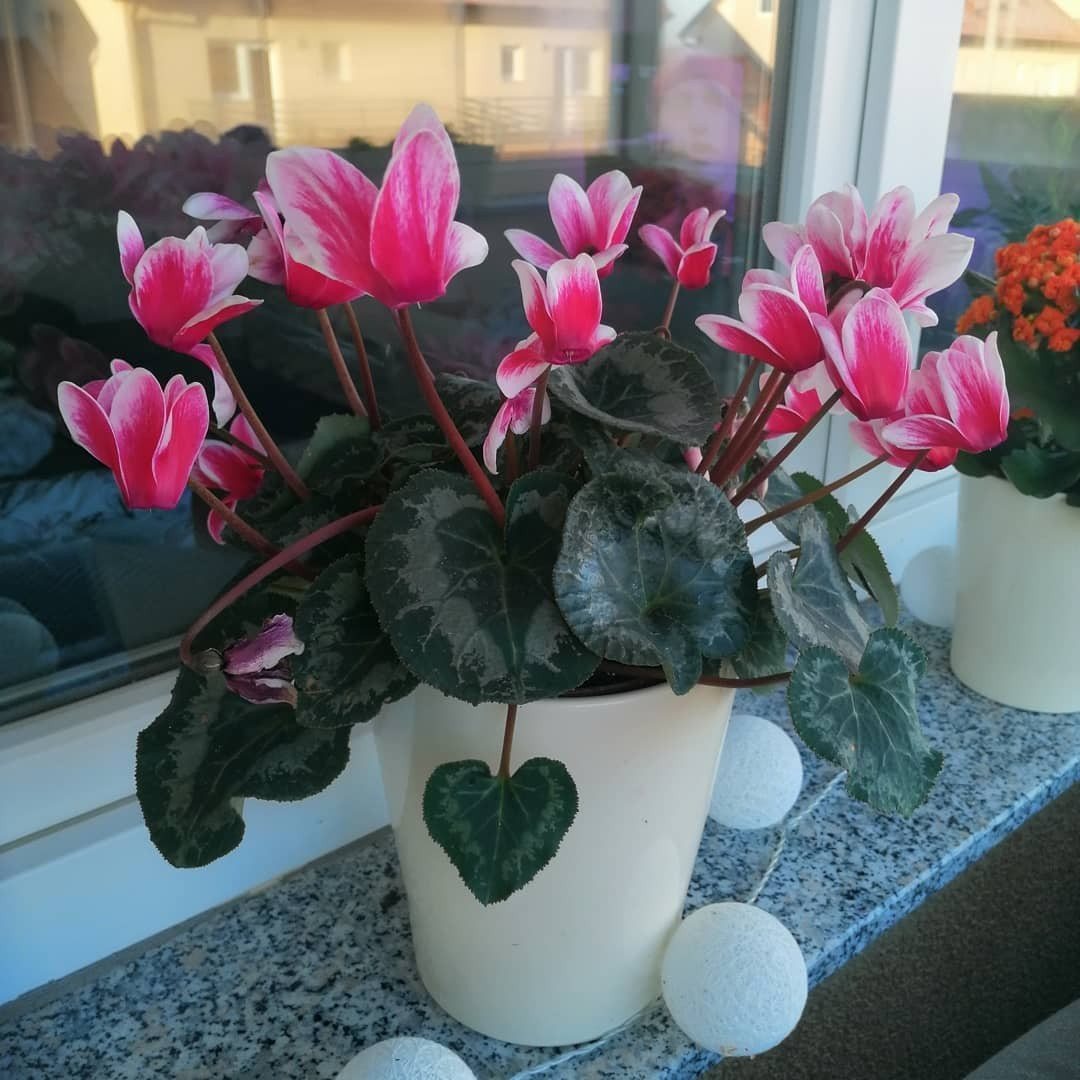
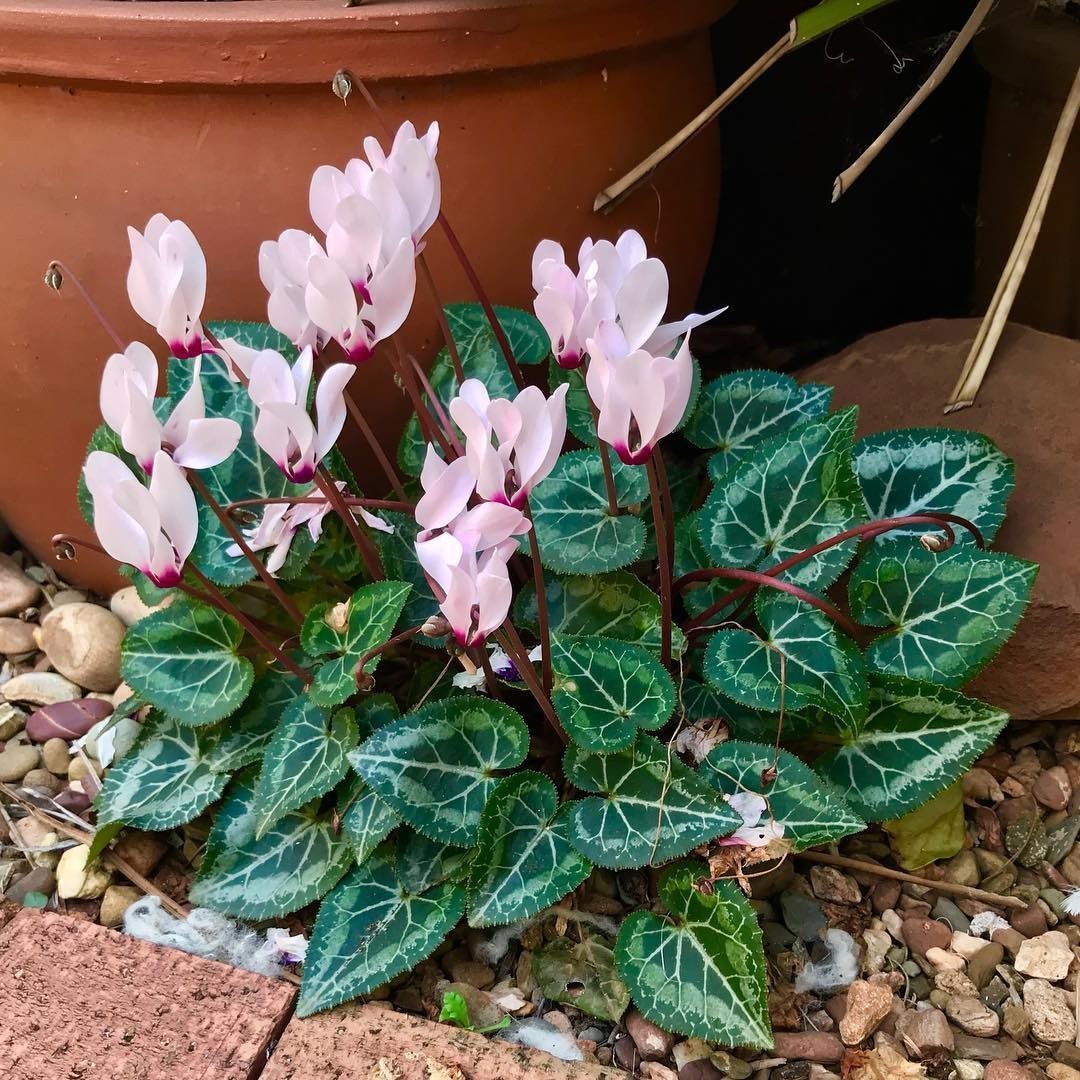
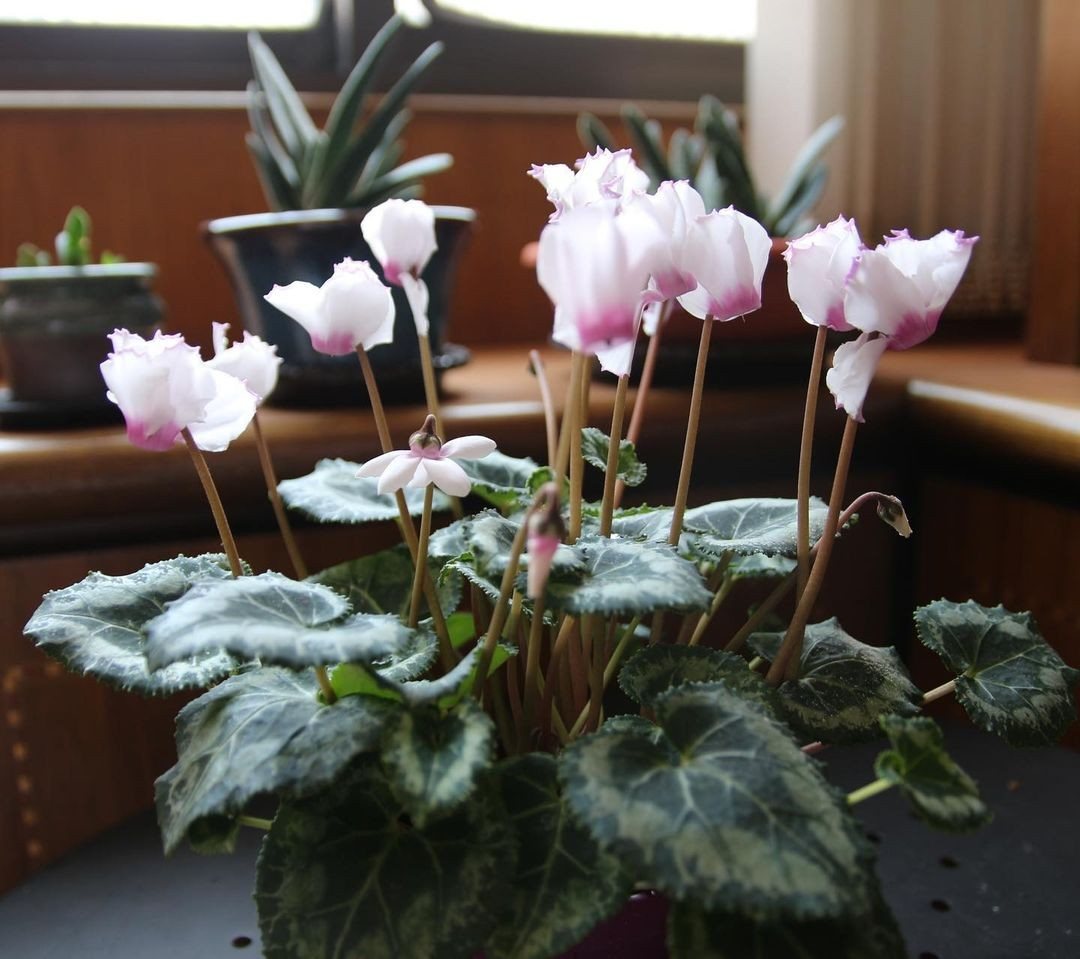
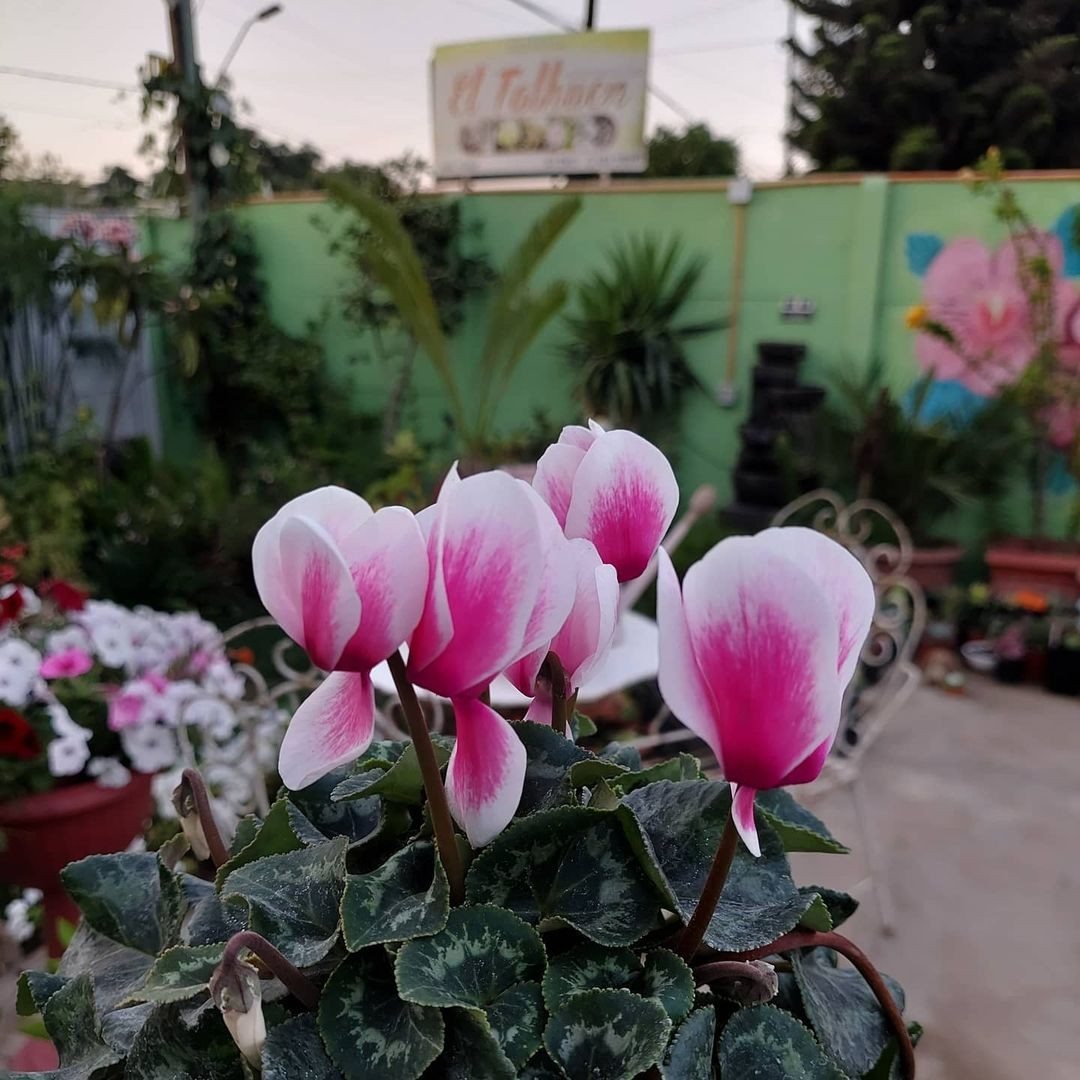






Caucasian
Caucasian or Kos cyclamen is 20–30 cm high. It grows in the Krasnodar region, the Caucasus, the Balkans and the eastern Mediterranean. This cyclamen was included in the Red Book of Russia. The basal rosette is formed by large kidney-shaped leaves with silver veins. The plant has a velvety dark tuber.
Popular varieties:
- "Maurice Dryden."Plants with silver-marbled leaves and white flowers.
- "Roseum". Plants of this variety have pink-red flowers with a dark center.
Cyclamen blooms in mid-spring. The petals bend and taper towards the base.
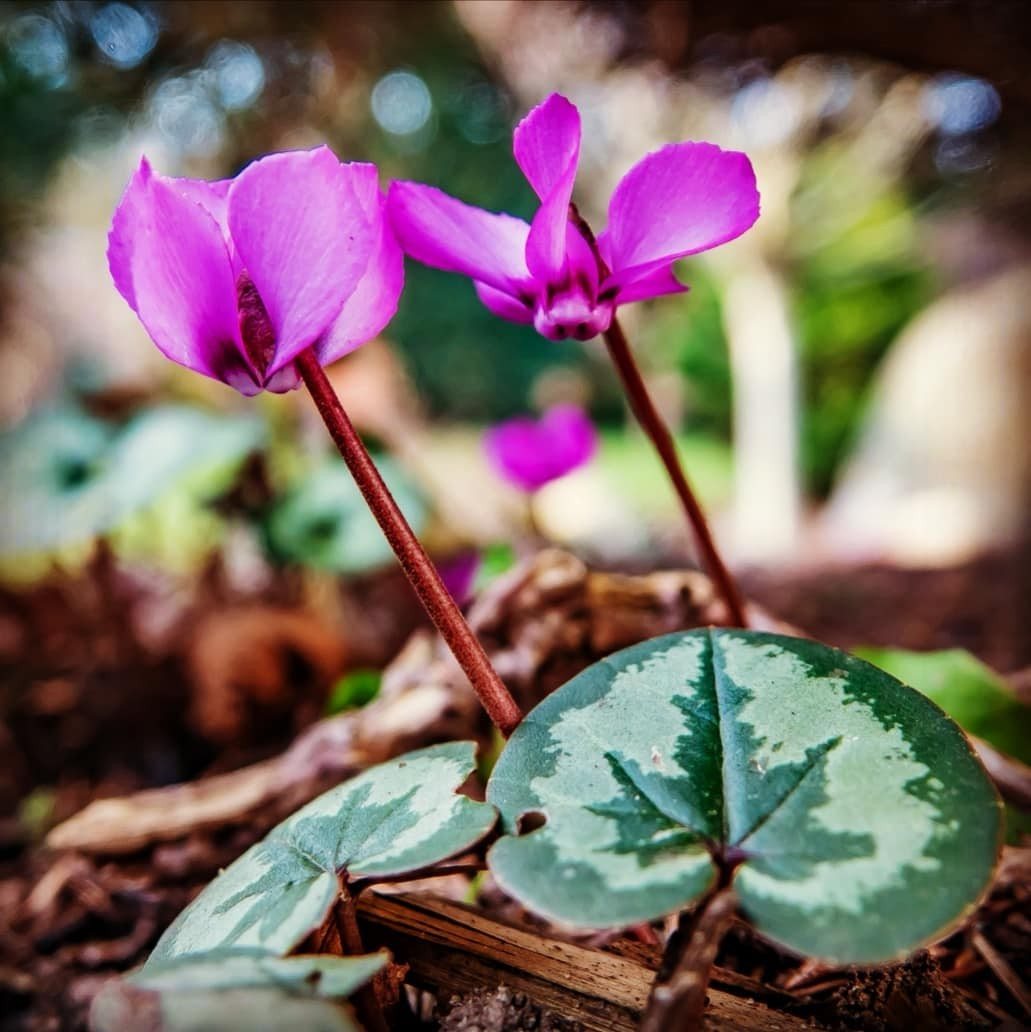
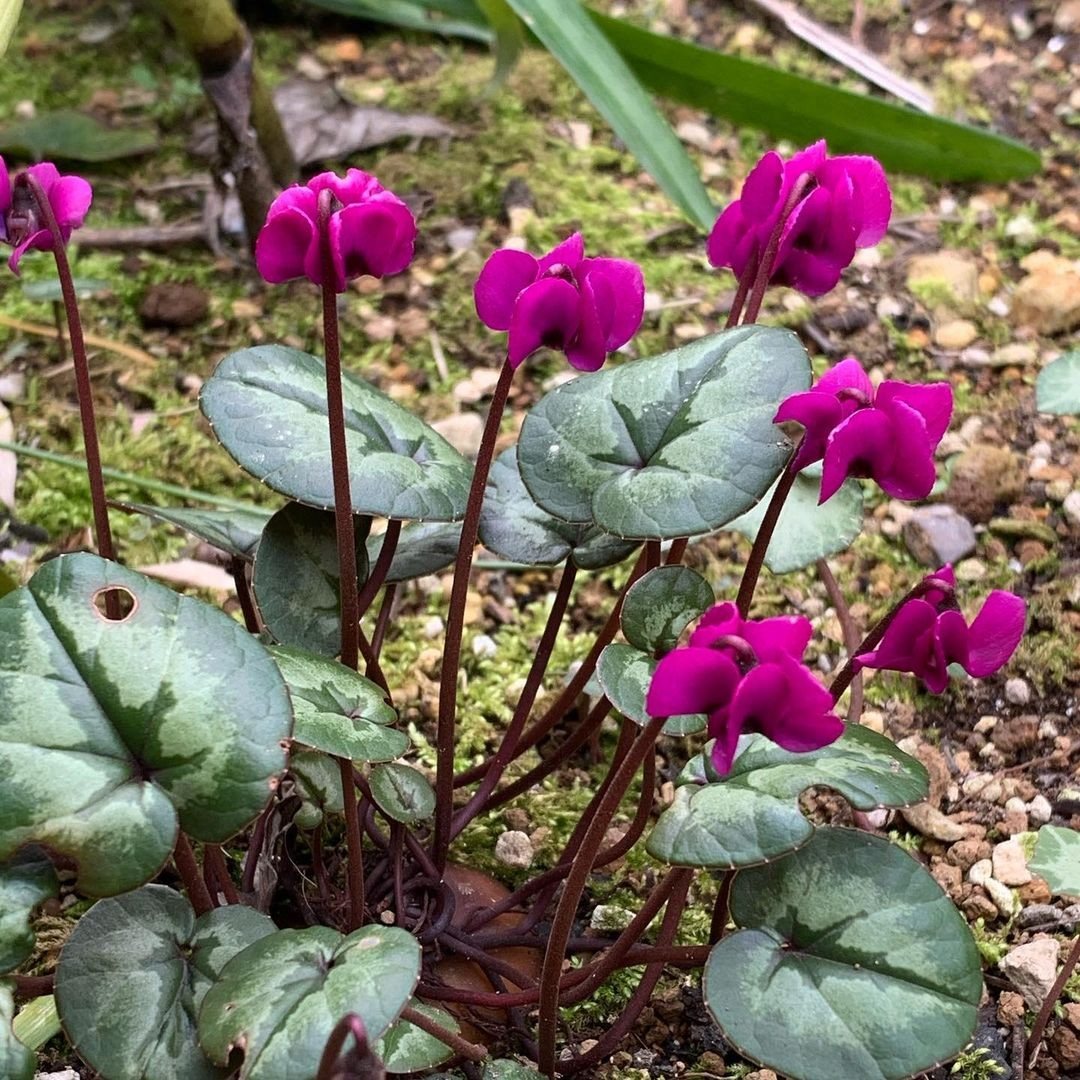
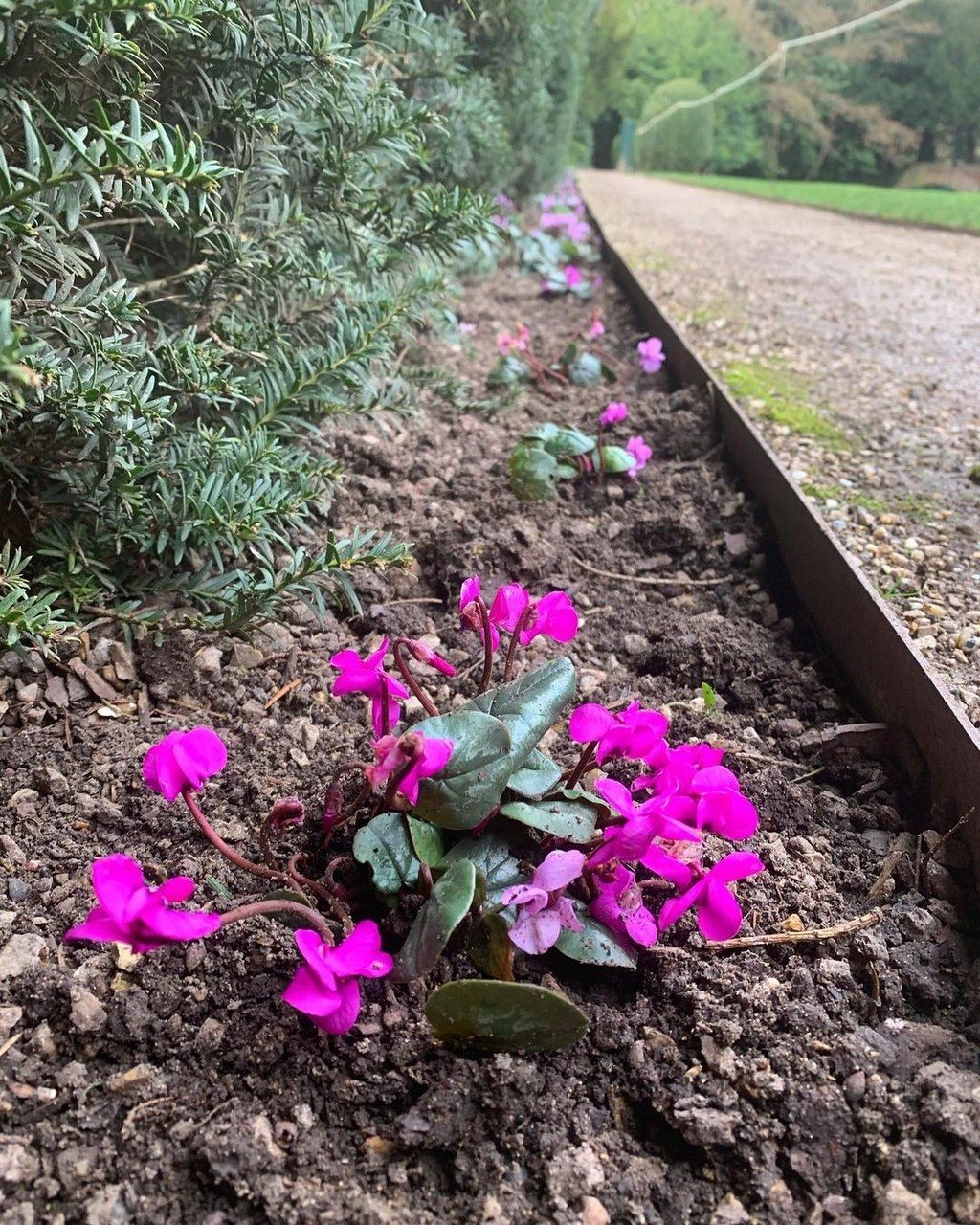

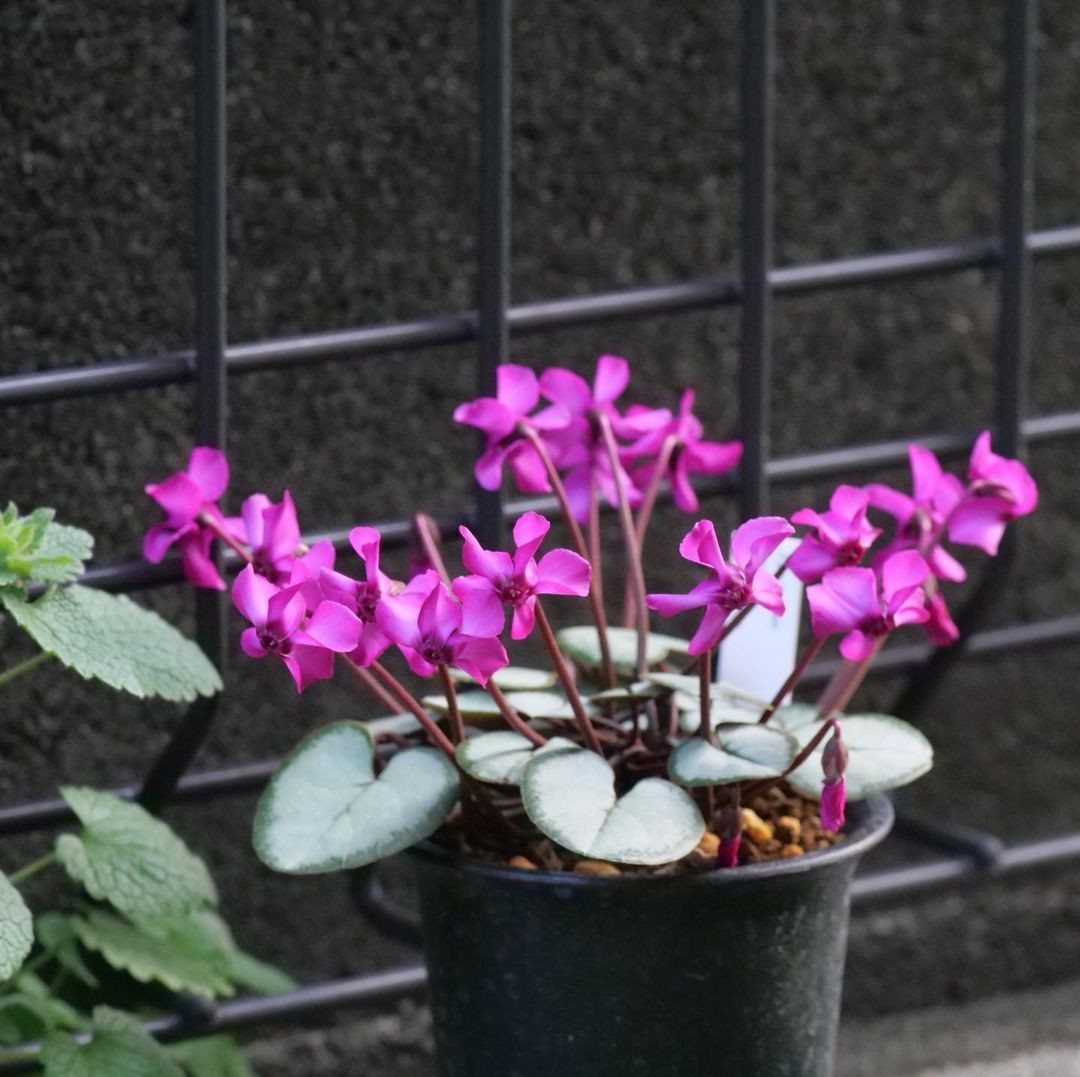





African
African cyclamen flowers are light to deep pink. Flowering begins in spring and ends in autumn. The flowers have a delicate scent.
African cyclamen is characterized by the appearance of buds, then the leaves bloom.
Cold and sunlight are very unpleasant for the plant.
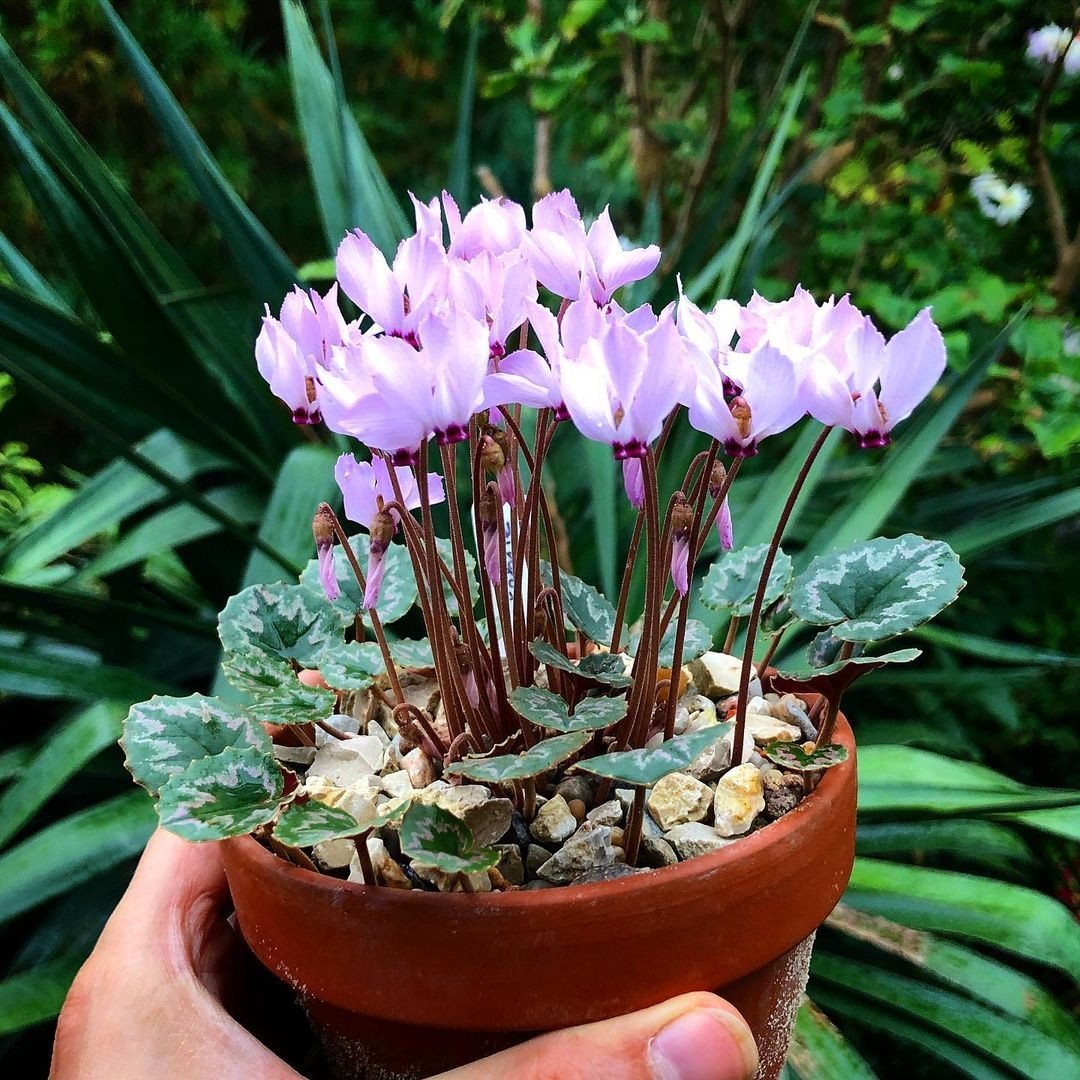
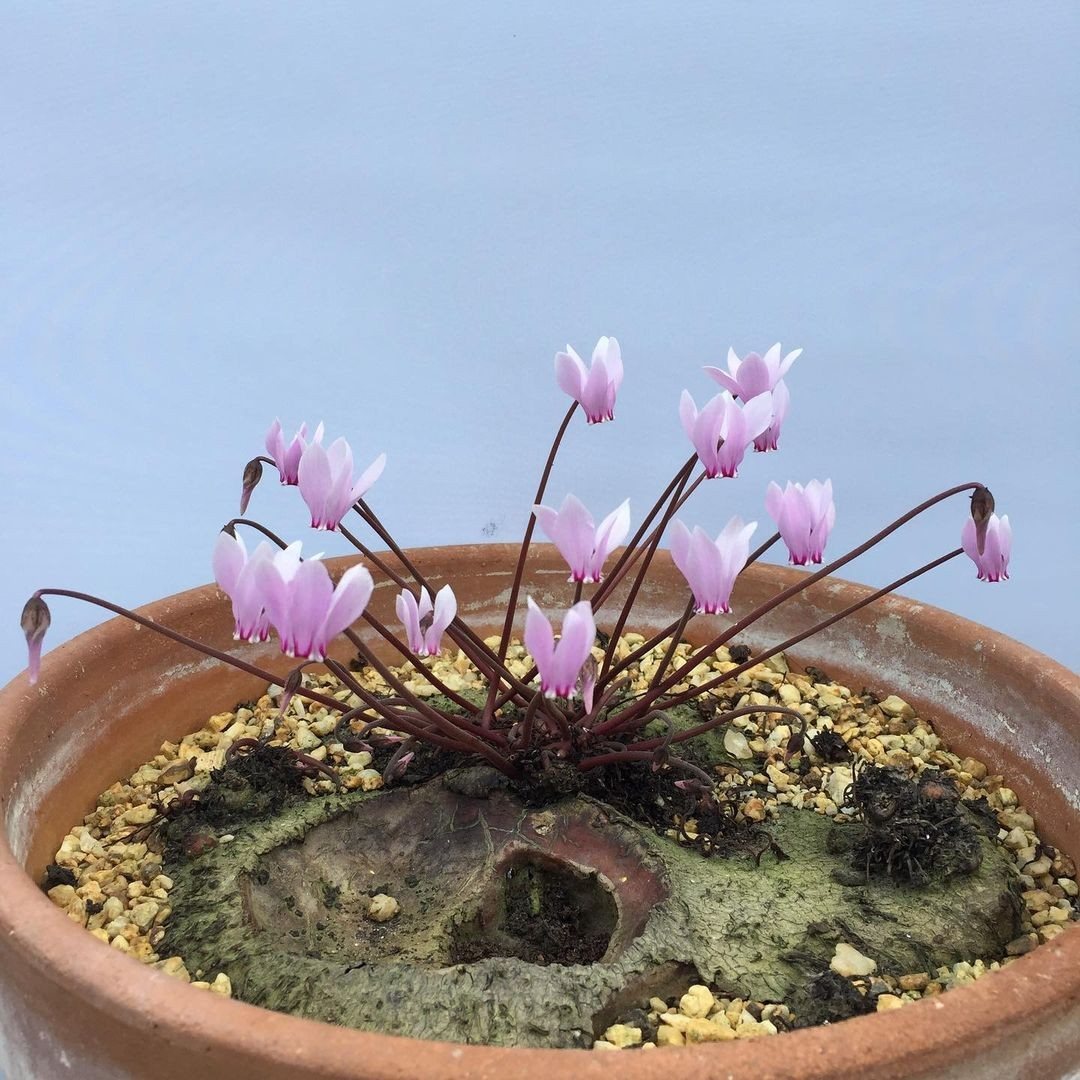

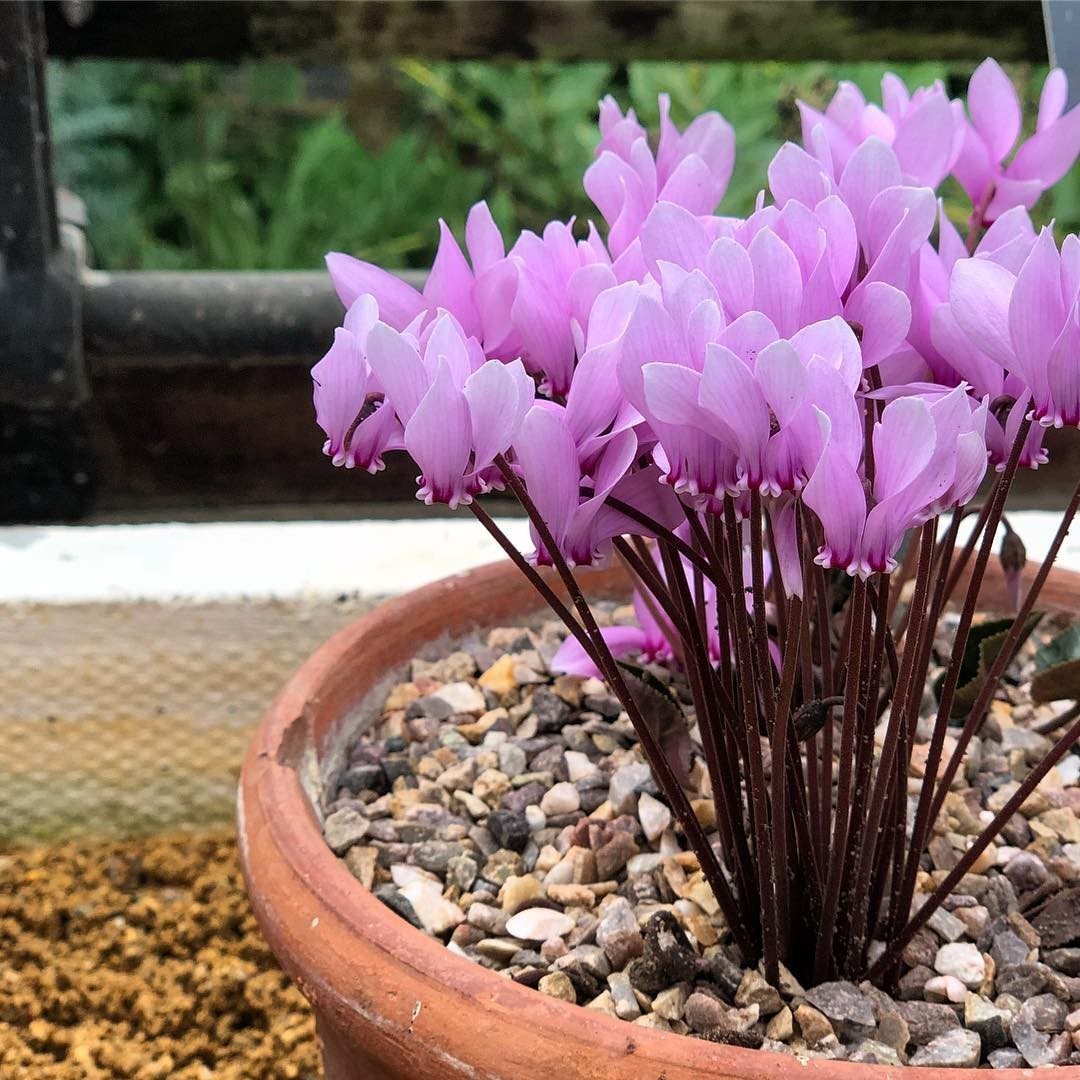
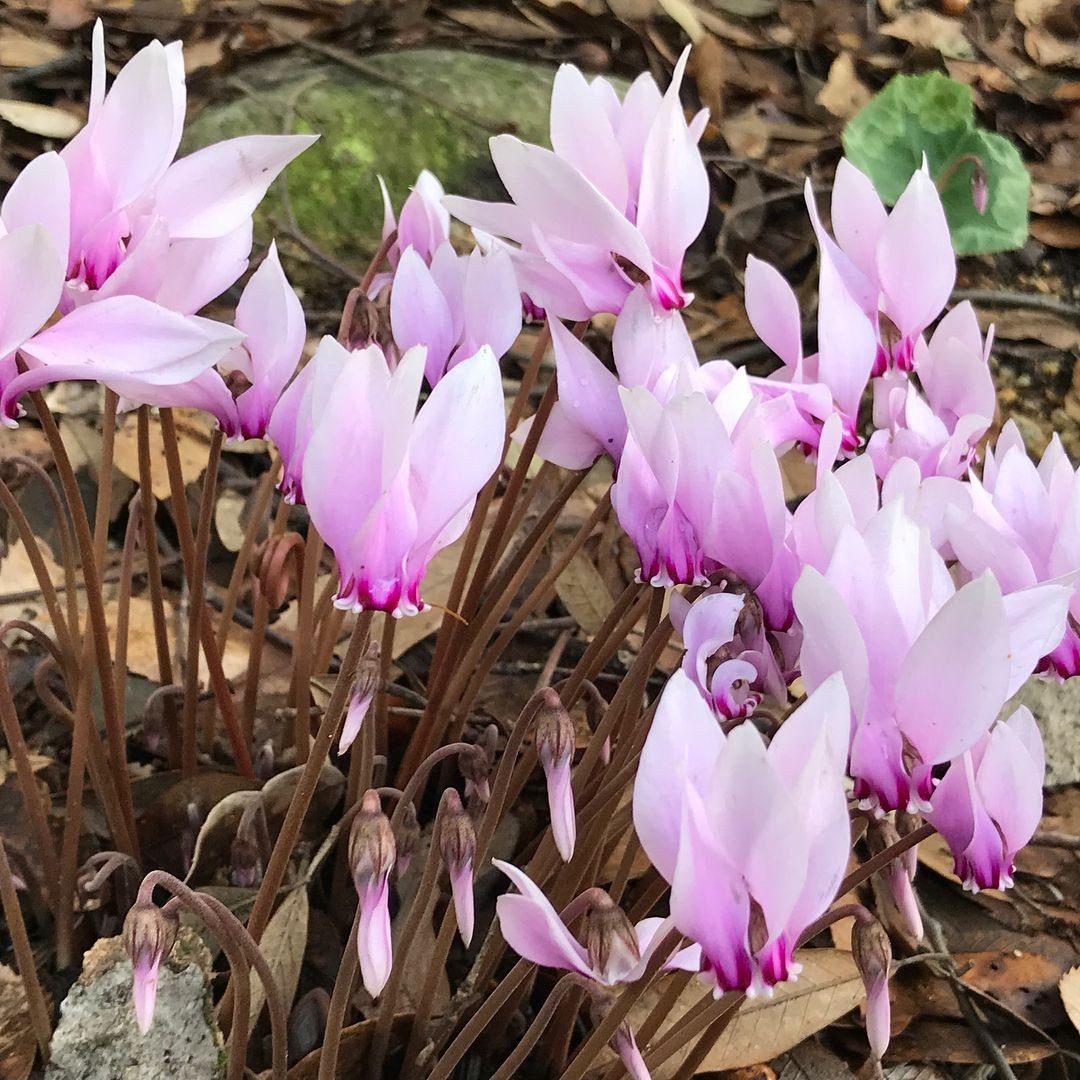





Ivy-leaved
Cyclamen ivy or Neapolitan is considered the most resistant to cold. The plant is planted in parks and gardens as an ornamental. The Mediterranean is its natural habitat.
The species is distinguished by leaves similar in shape to ivy foliage. Blooms in autumn. Pink flowers.
Popular varieties:
- "White Veil". Blooms in the second year of sowing. White flowers exude a pleasant scent. Bush height - 25 cm.
- "Pink Blanket" The flowers are pale pink. There are always a lot of them, they bloom magnificently.
When planting, the tuber is buried deeper than other species. The roots grow in the upper part, so the tuber should be located at least 10 cm underground.
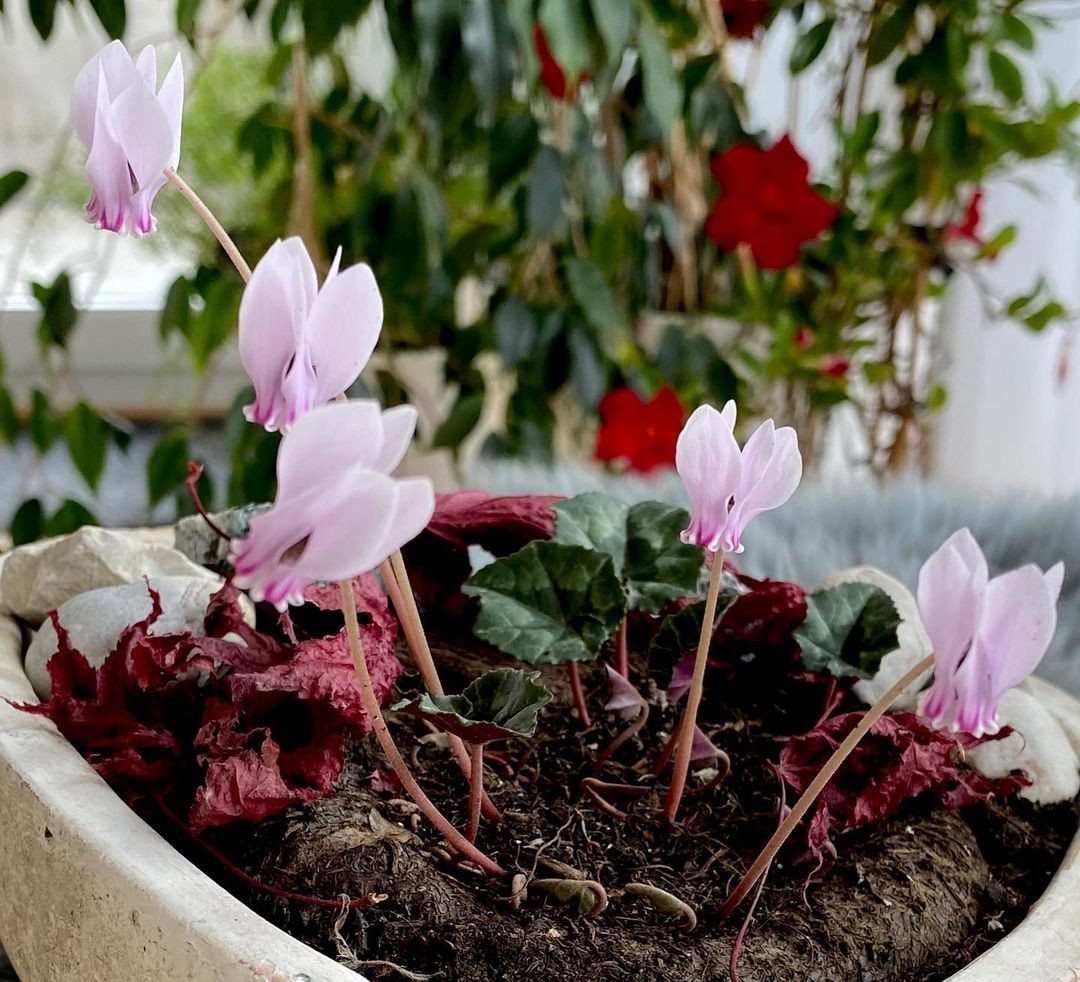
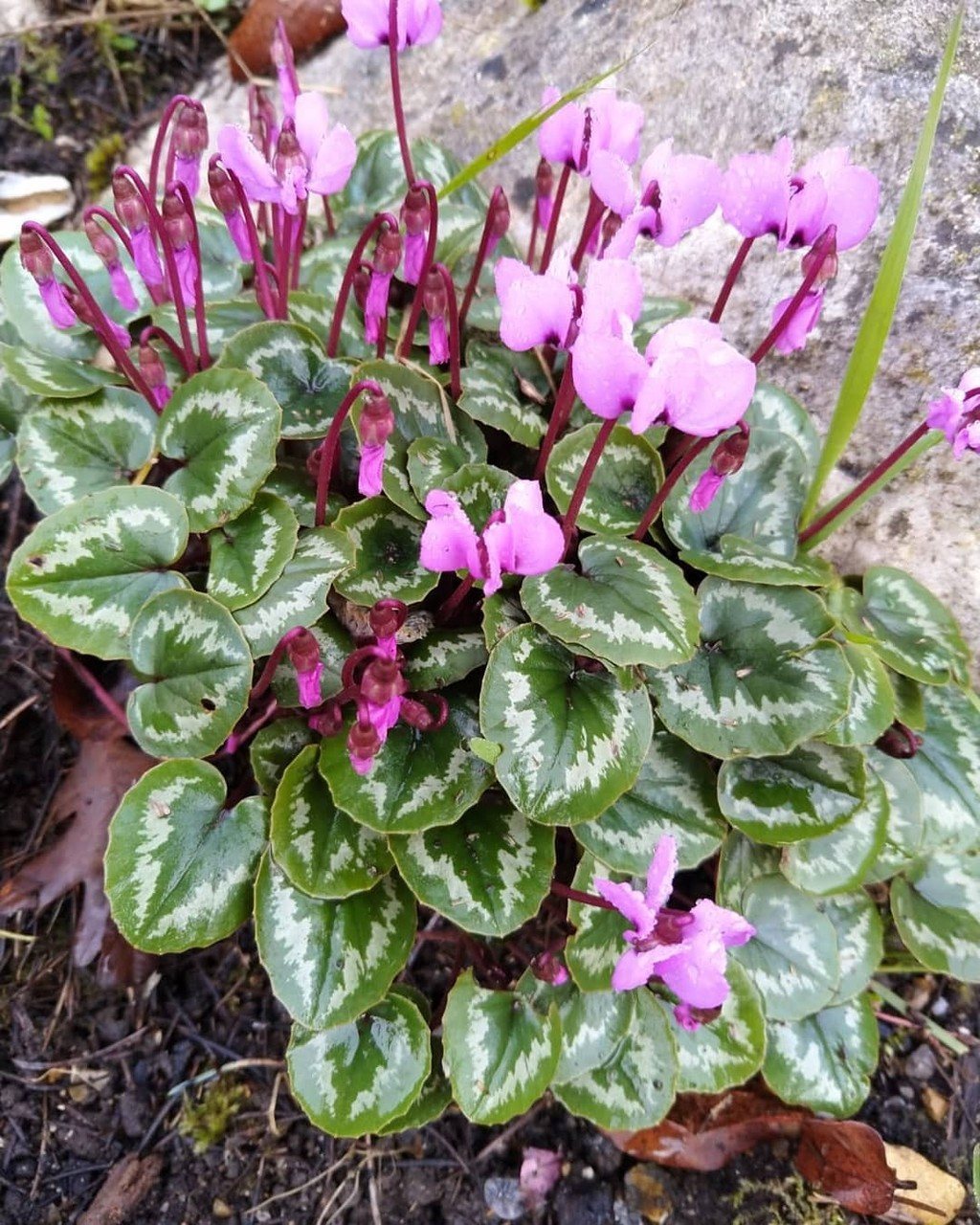
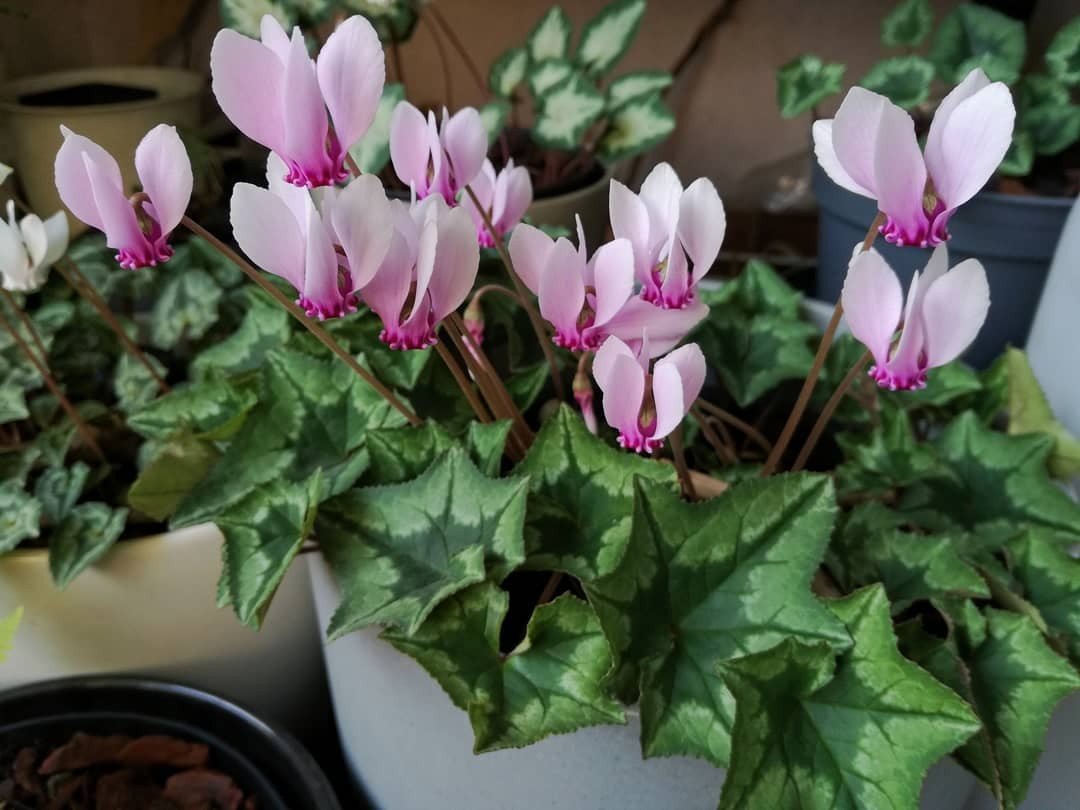
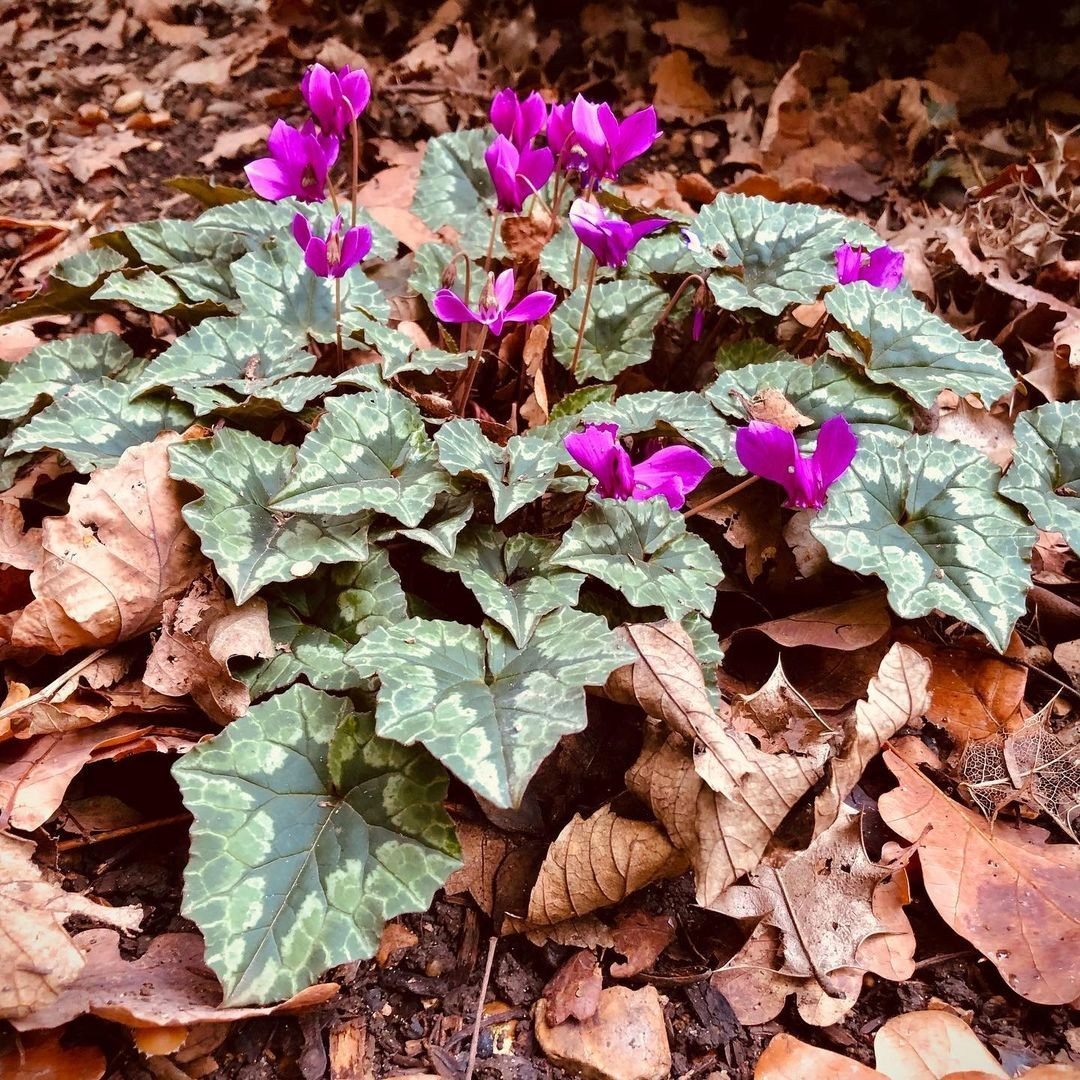
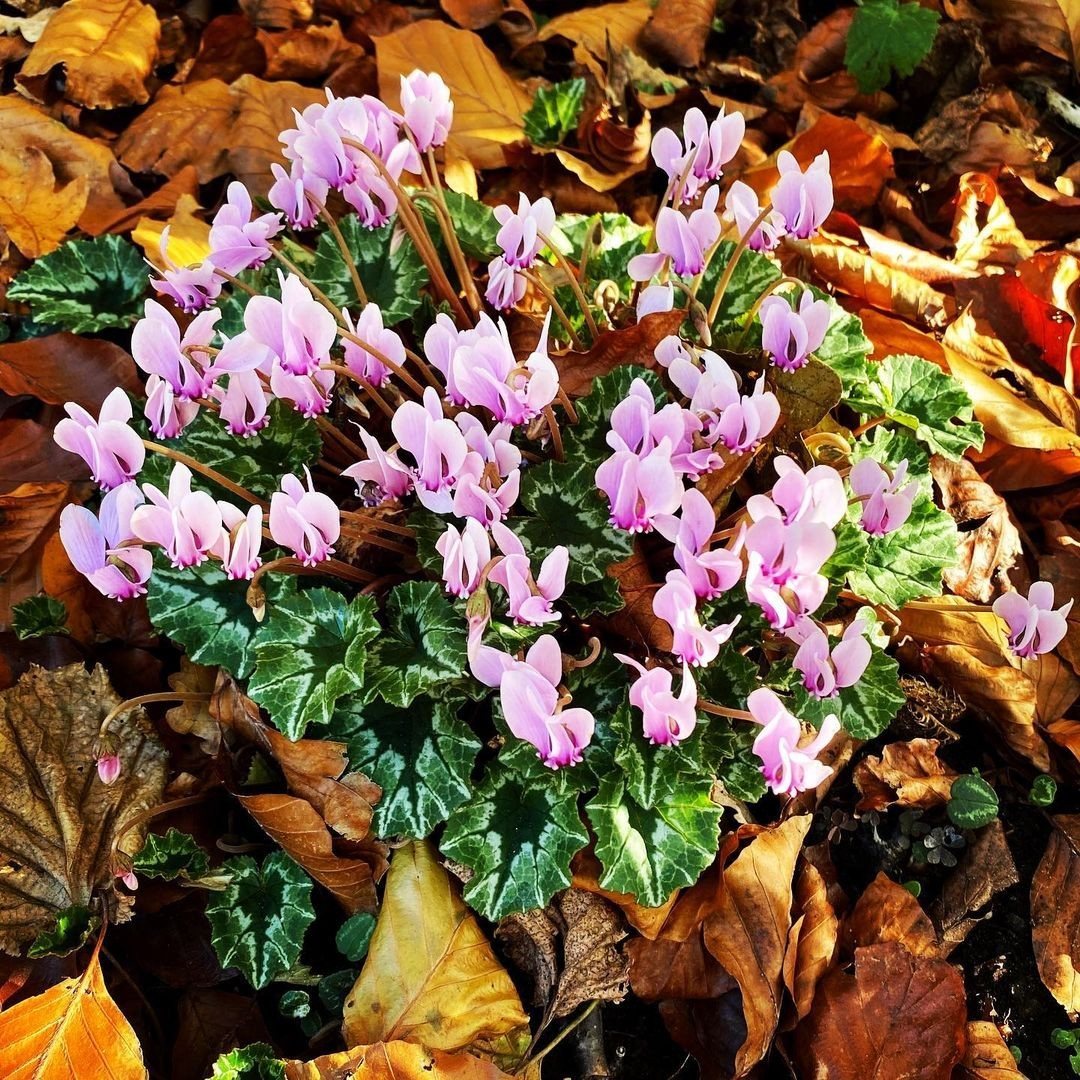





Cypriot
Cyclamen has been approved as the national symbol of the island of Cyprus. A small plant 7–15 cm tall has fleshy heart-shaped leaves. The flowers are light pink or white with a purple spot in the center. Blooms from late autumn to mid-winter.
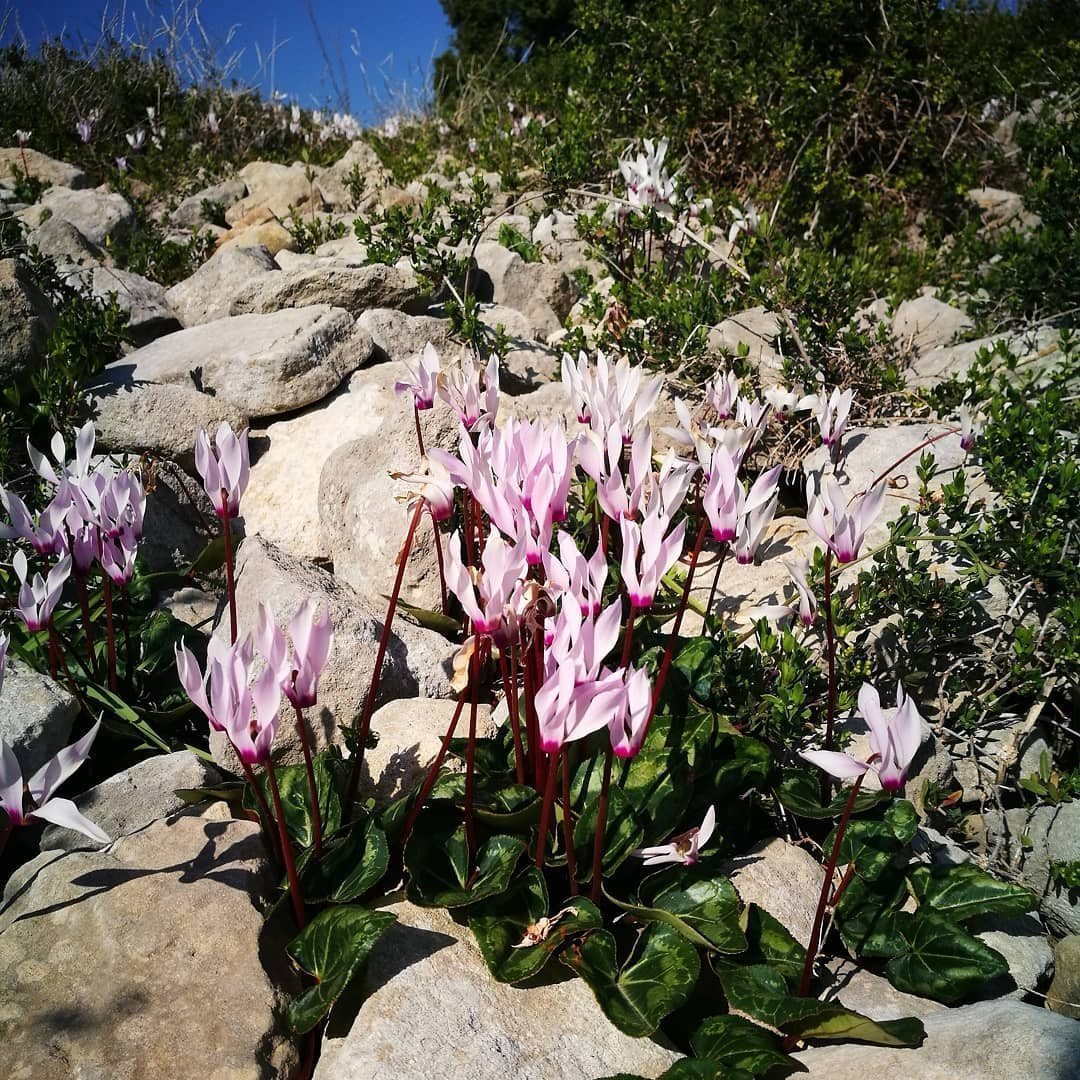
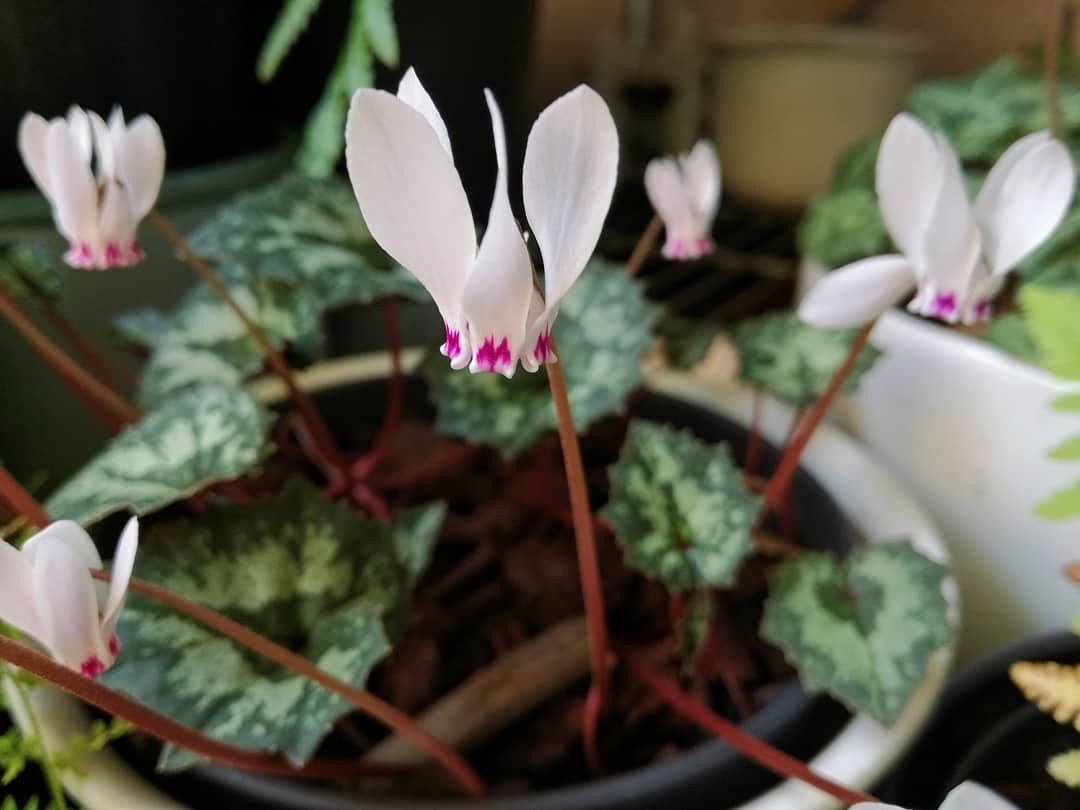

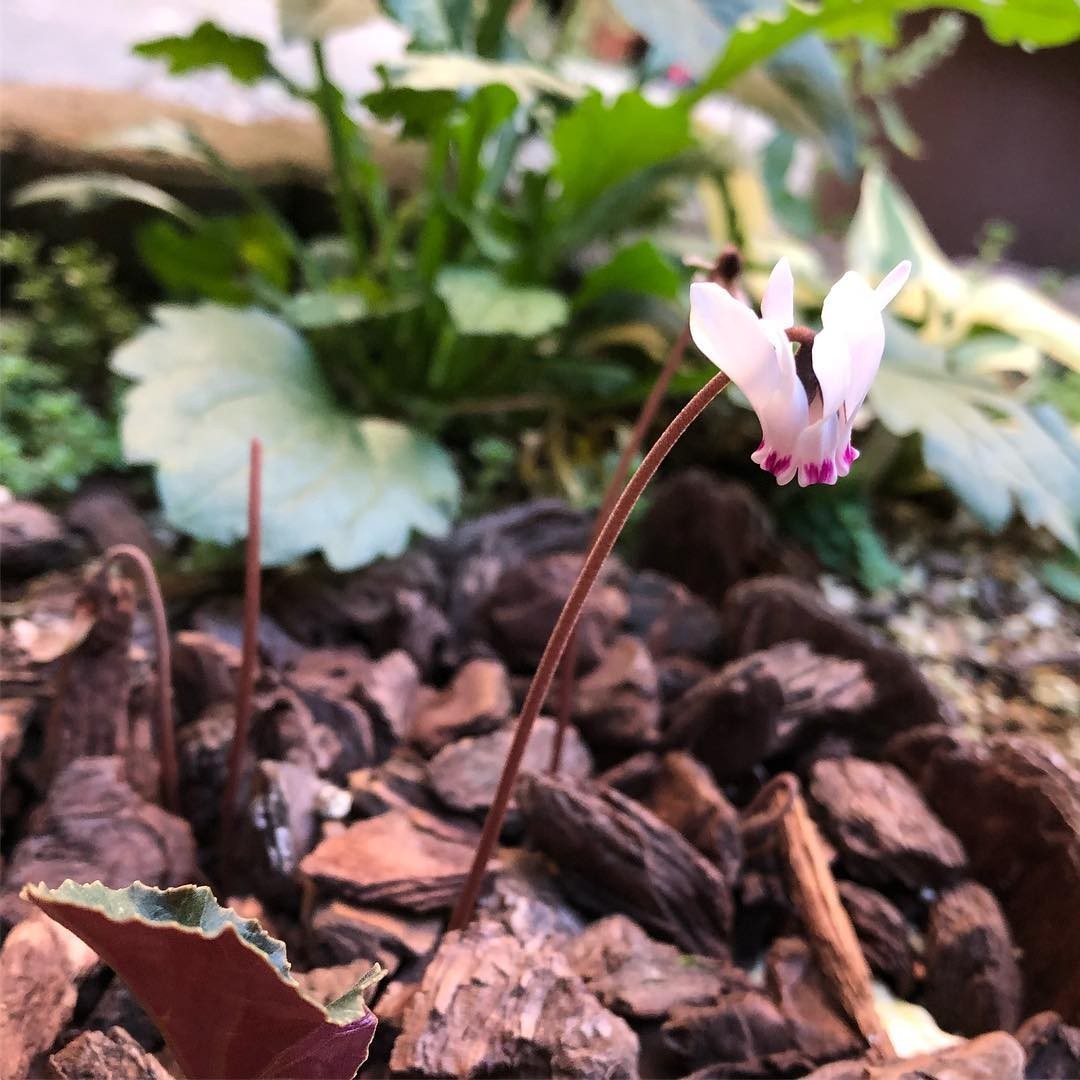
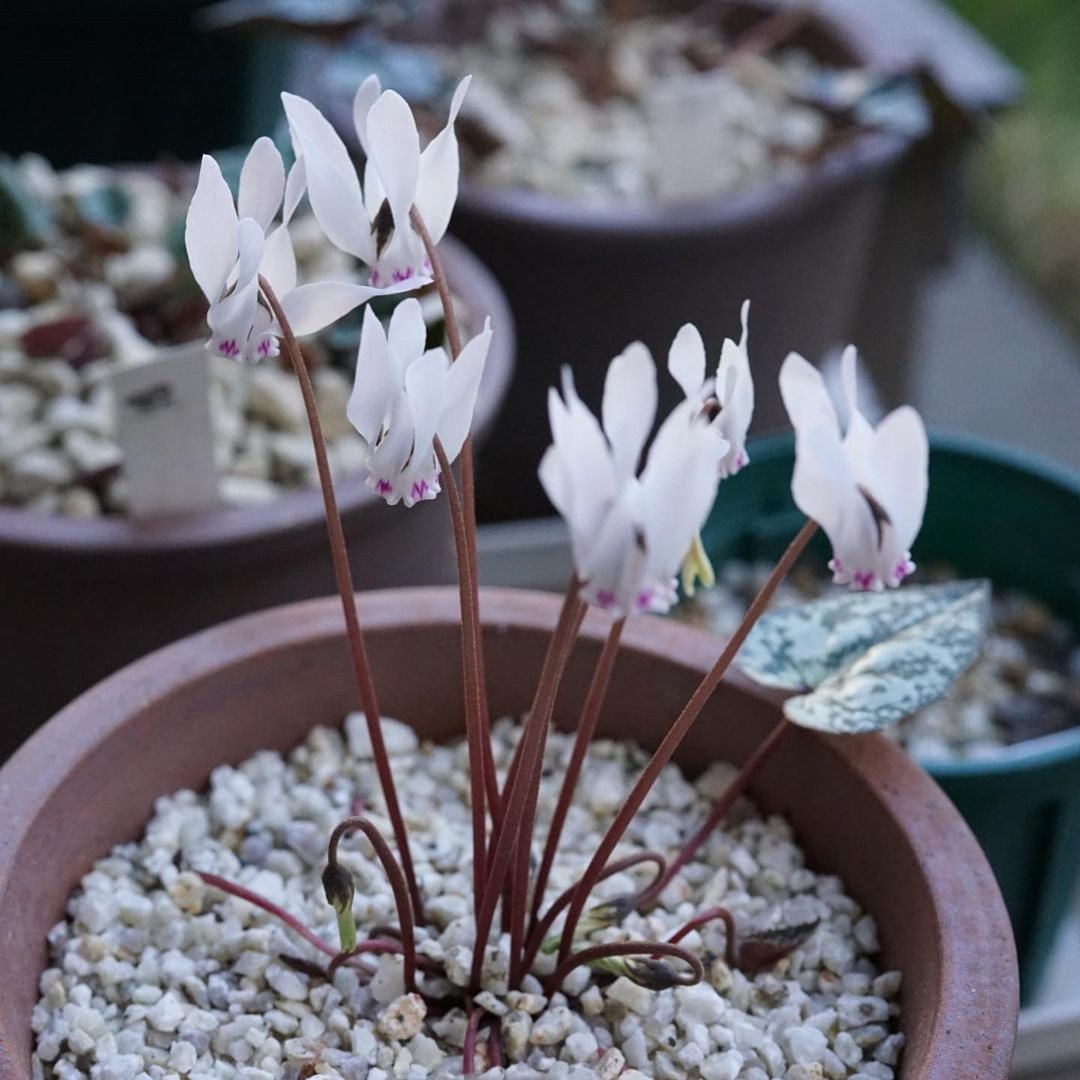





Colchis
Cyclamen Colchis or Pontic grows in Abkhazia. It is a variety of the European one, but its leaves are without silver veins and its flowers are smaller in size.
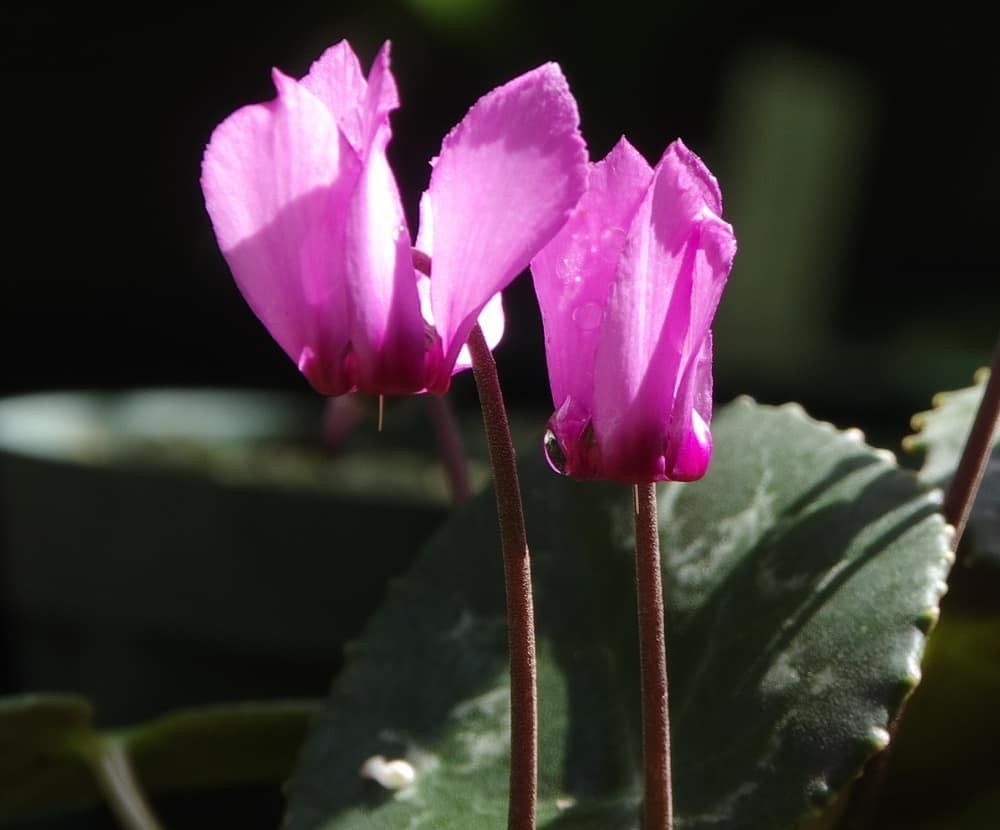
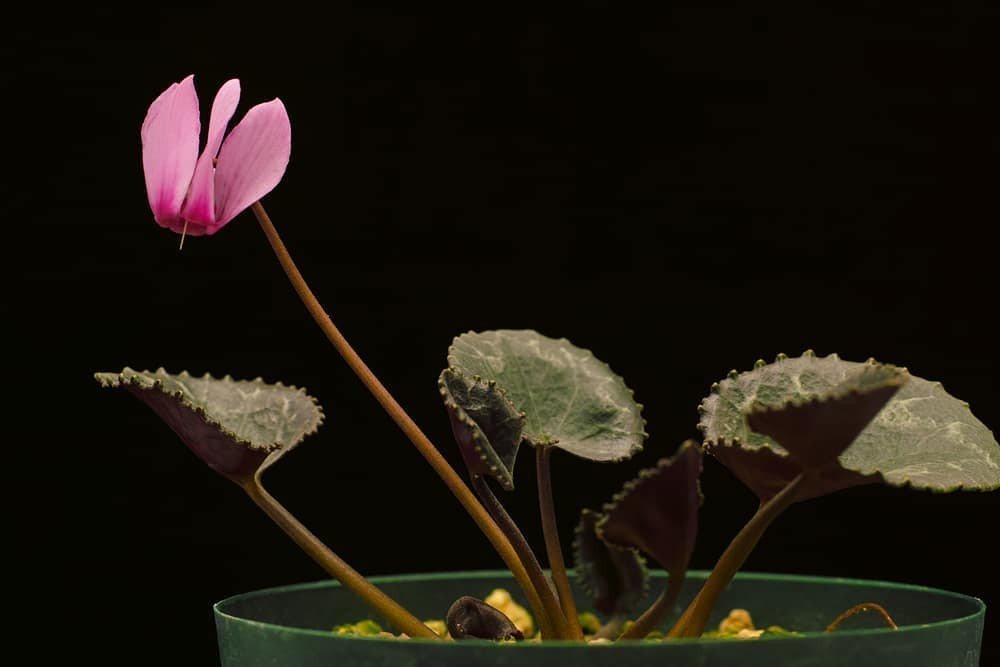
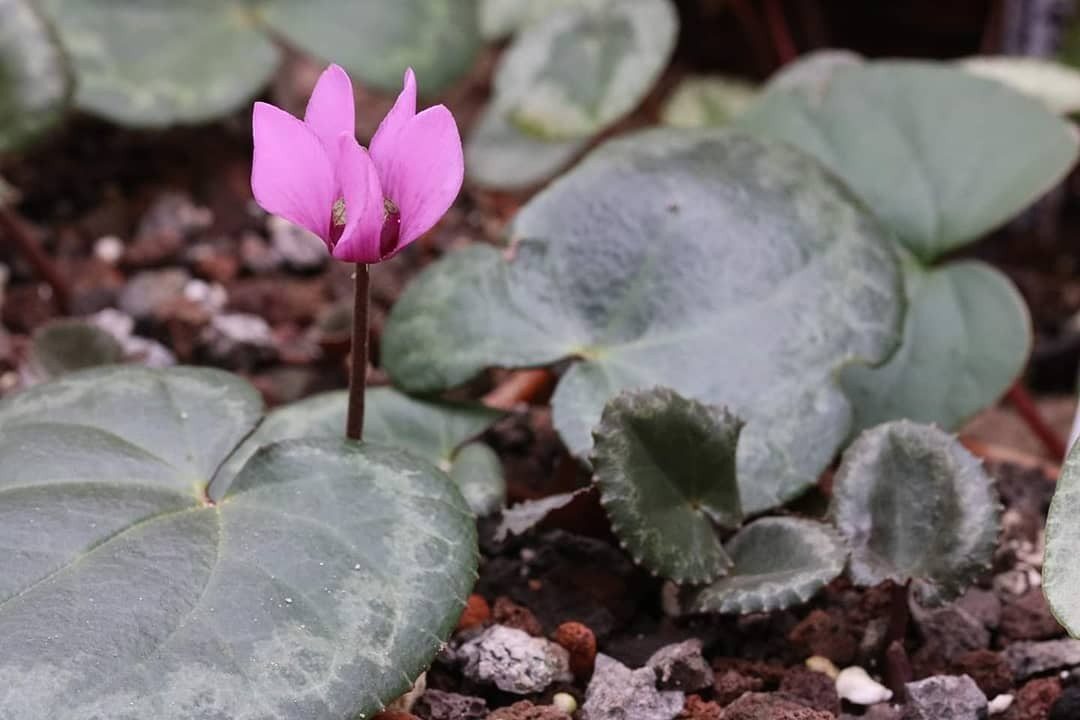
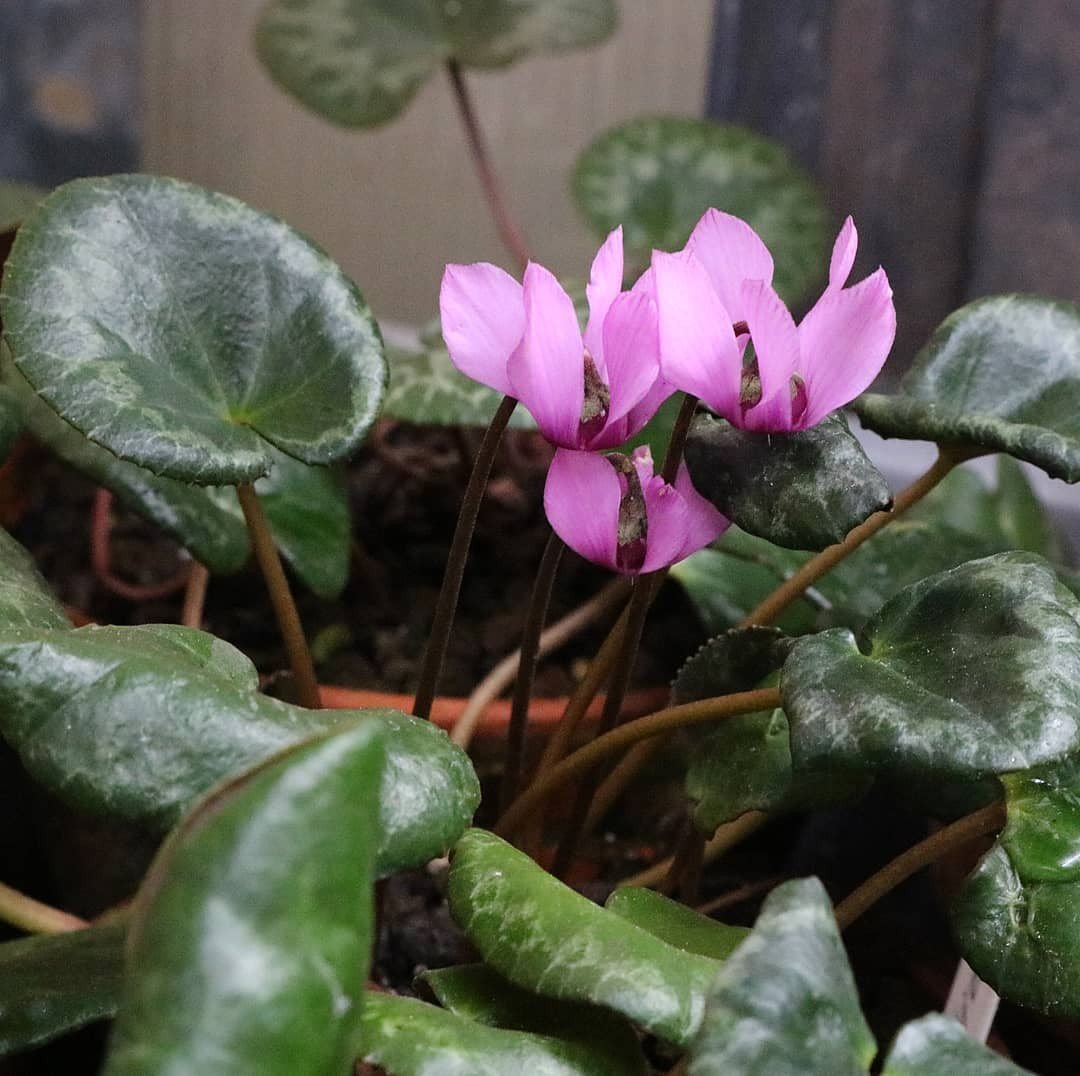
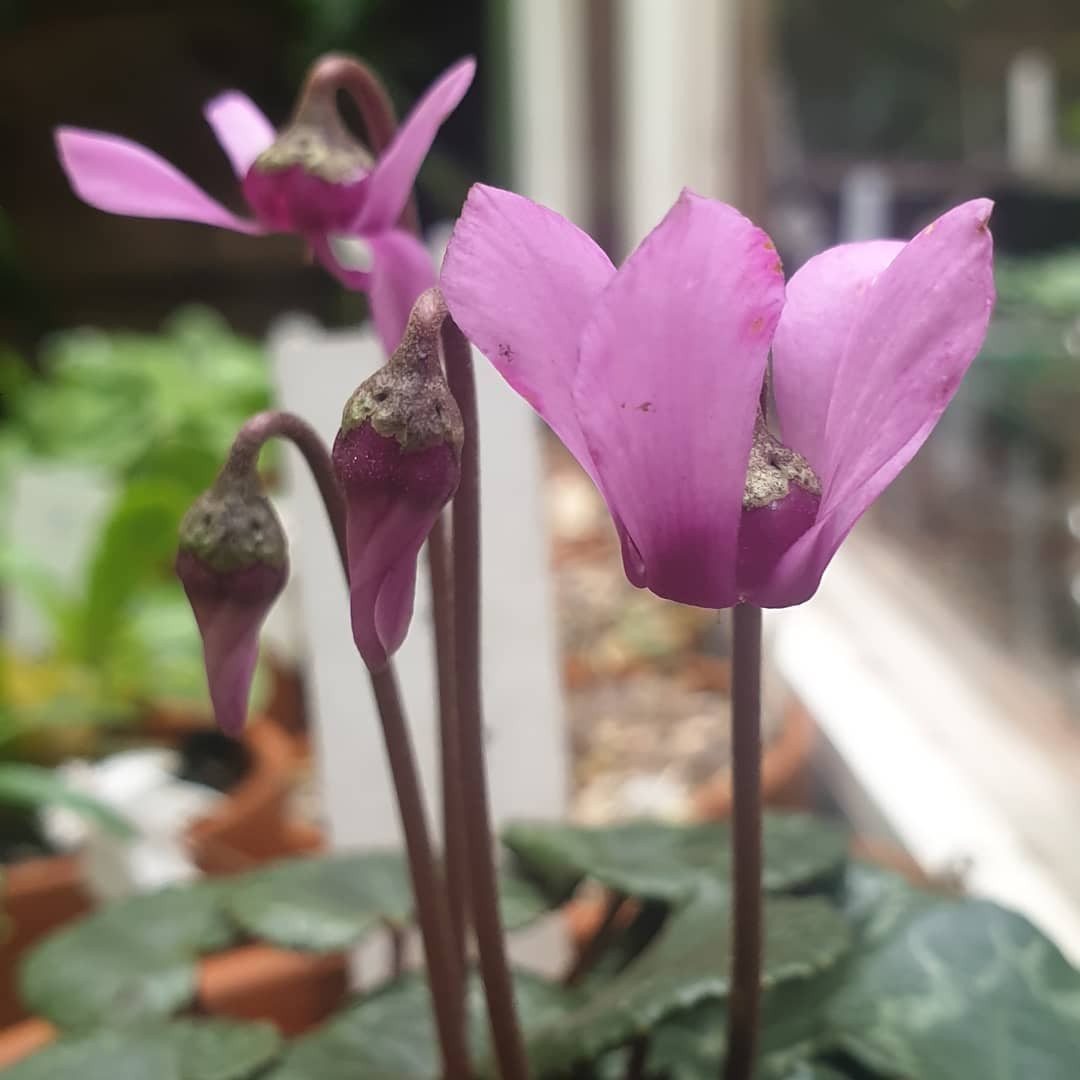





Greek
Greek cyclamen grows in Greece, on the islands of the eastern Aegean Sea, Rhodes, Crete, Cyprus and southern Turkey. The leaves are bright green with an unusual pattern (light center and dark border). Flowers range from pale pink to dark purple with a purple center.
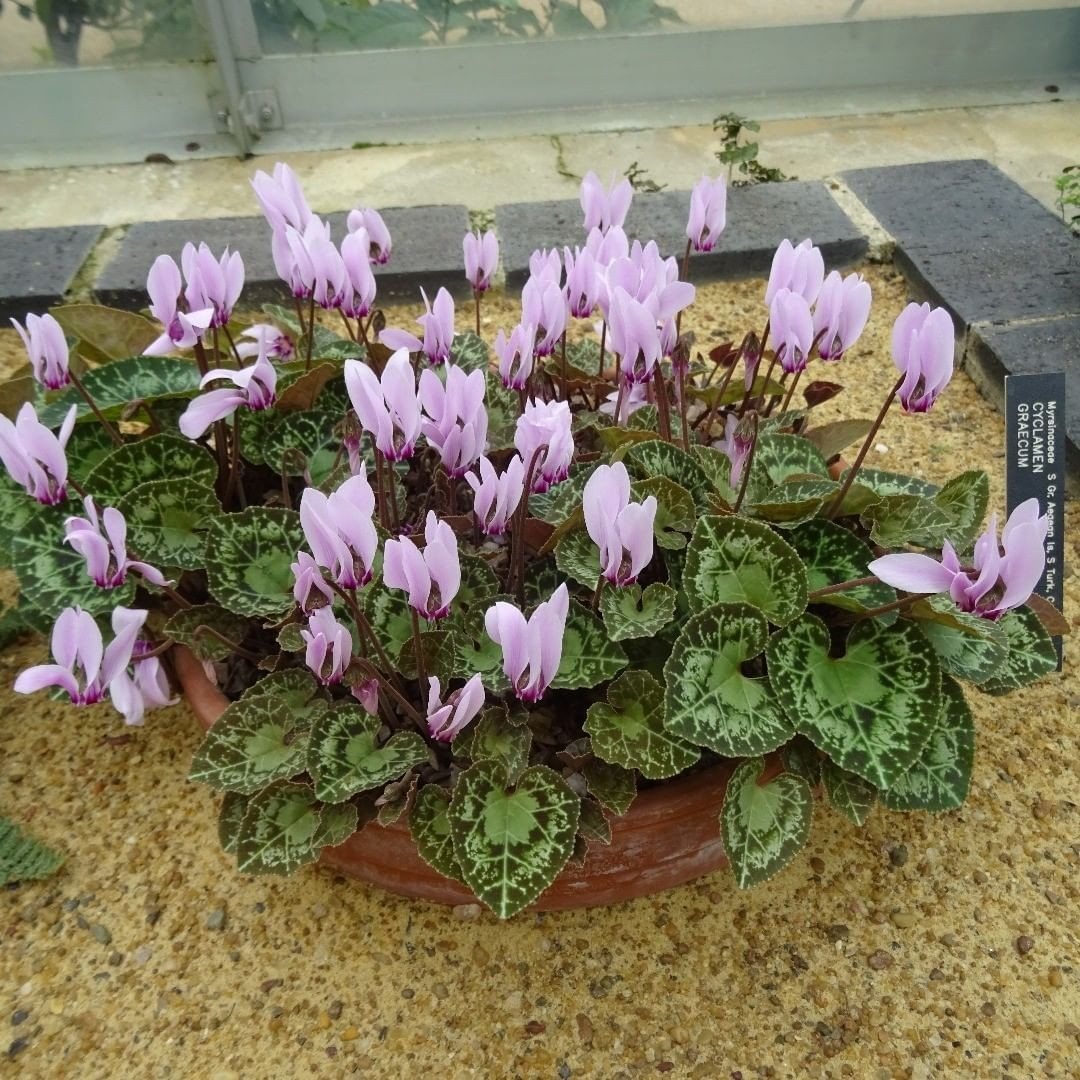

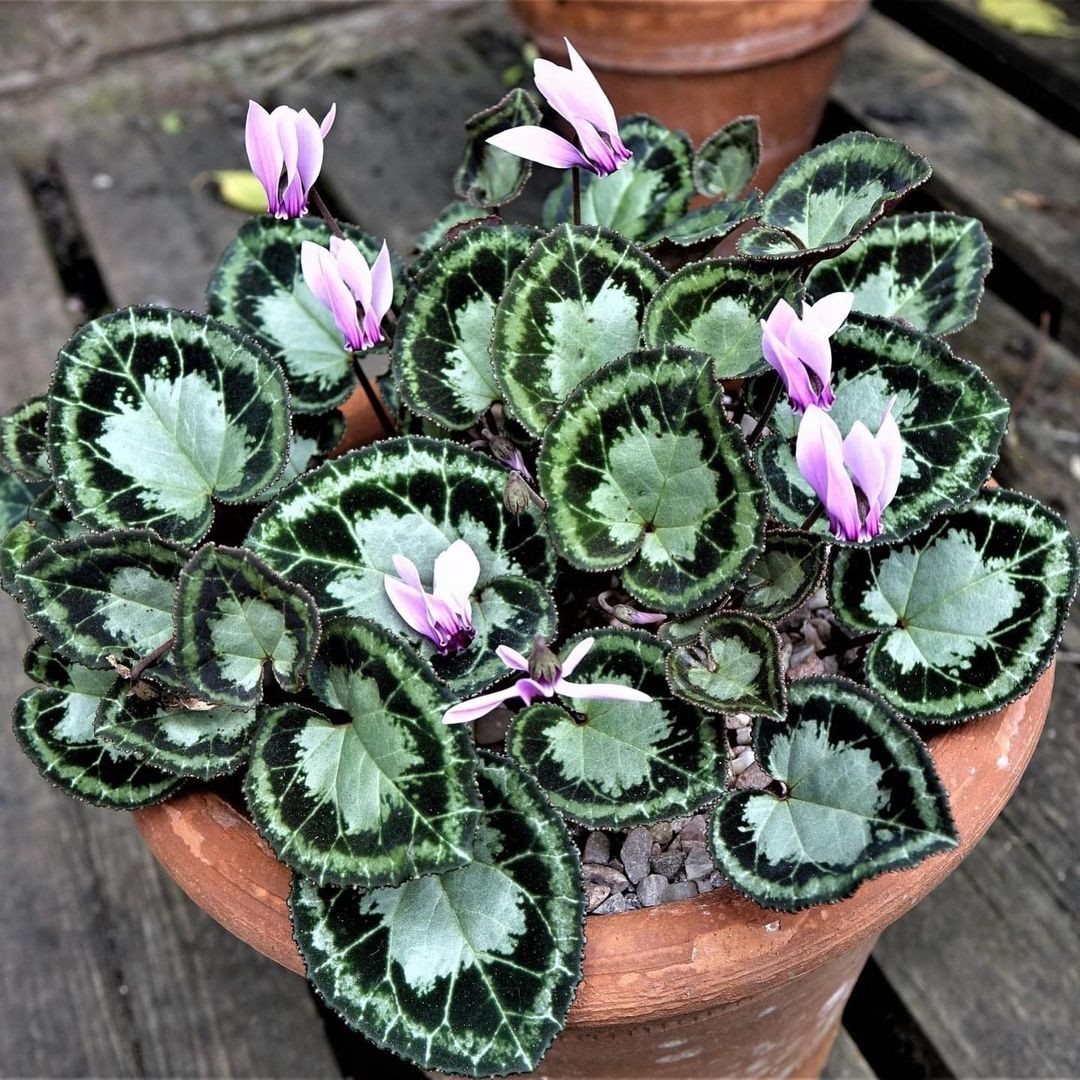
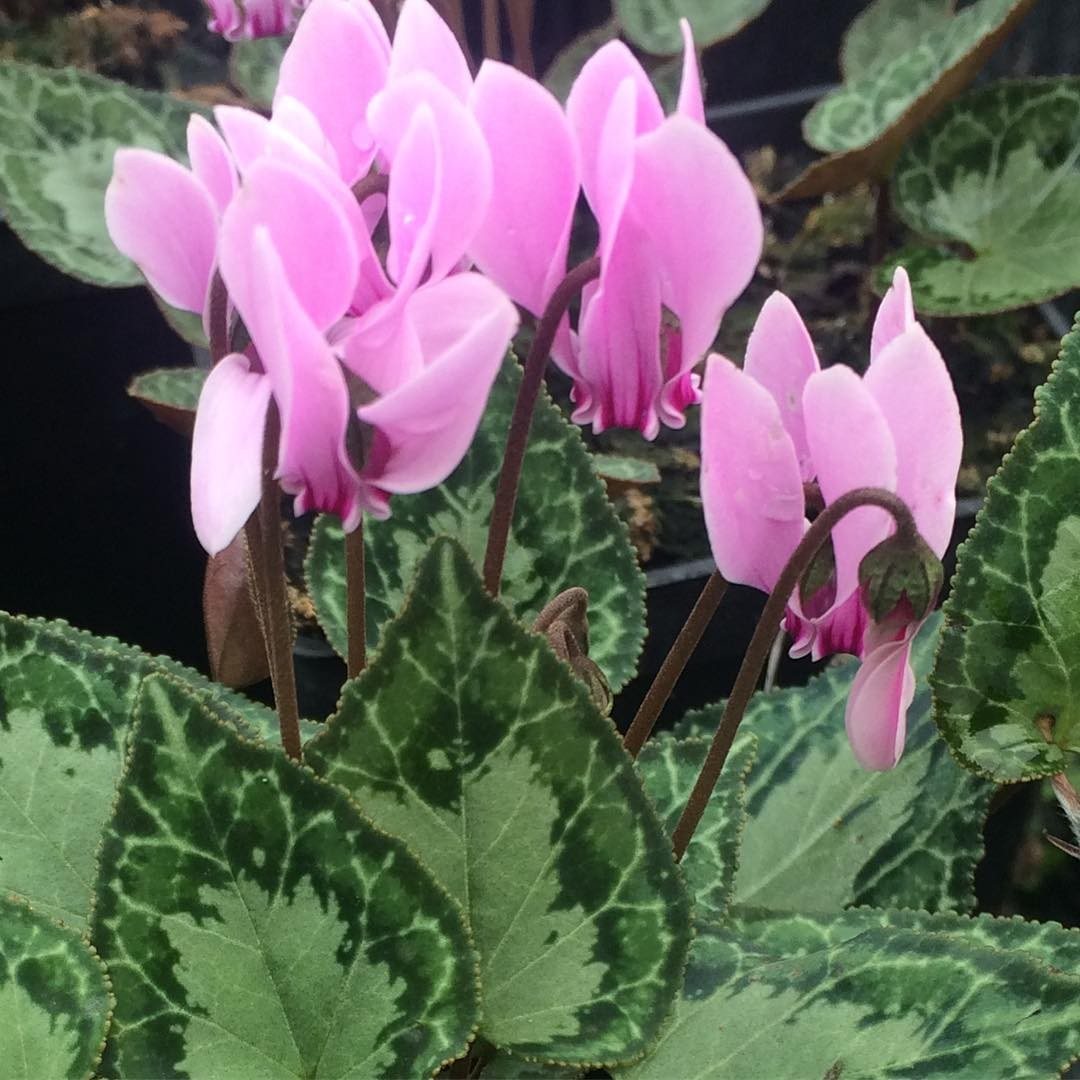
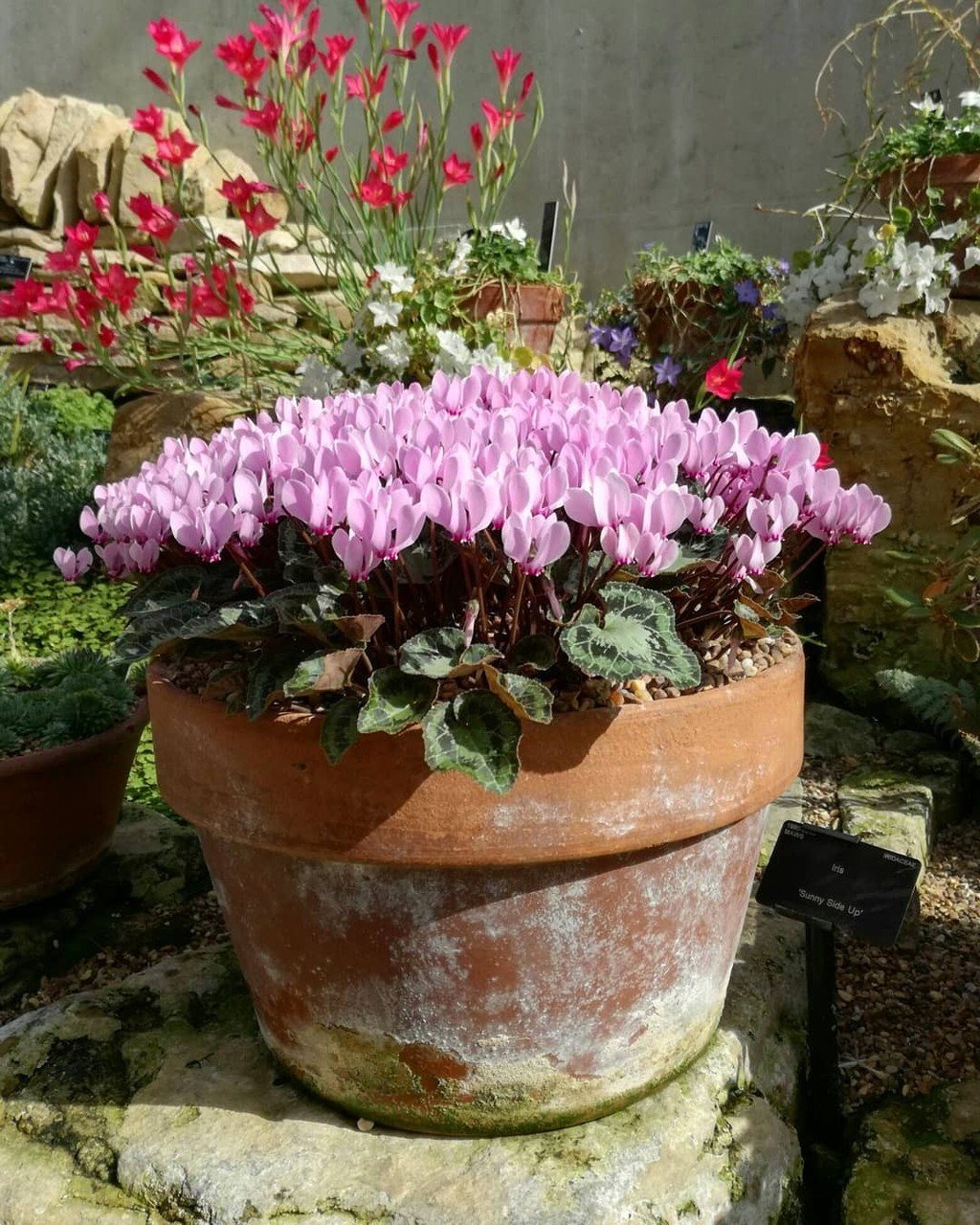





Lebanese
Cyclamen Lebanese has large flowers. When they first bloom their color is white. Towards the end of flowering it becomes pale pink. The petals have bright purple veins at the base. The leaves are oval, wide.
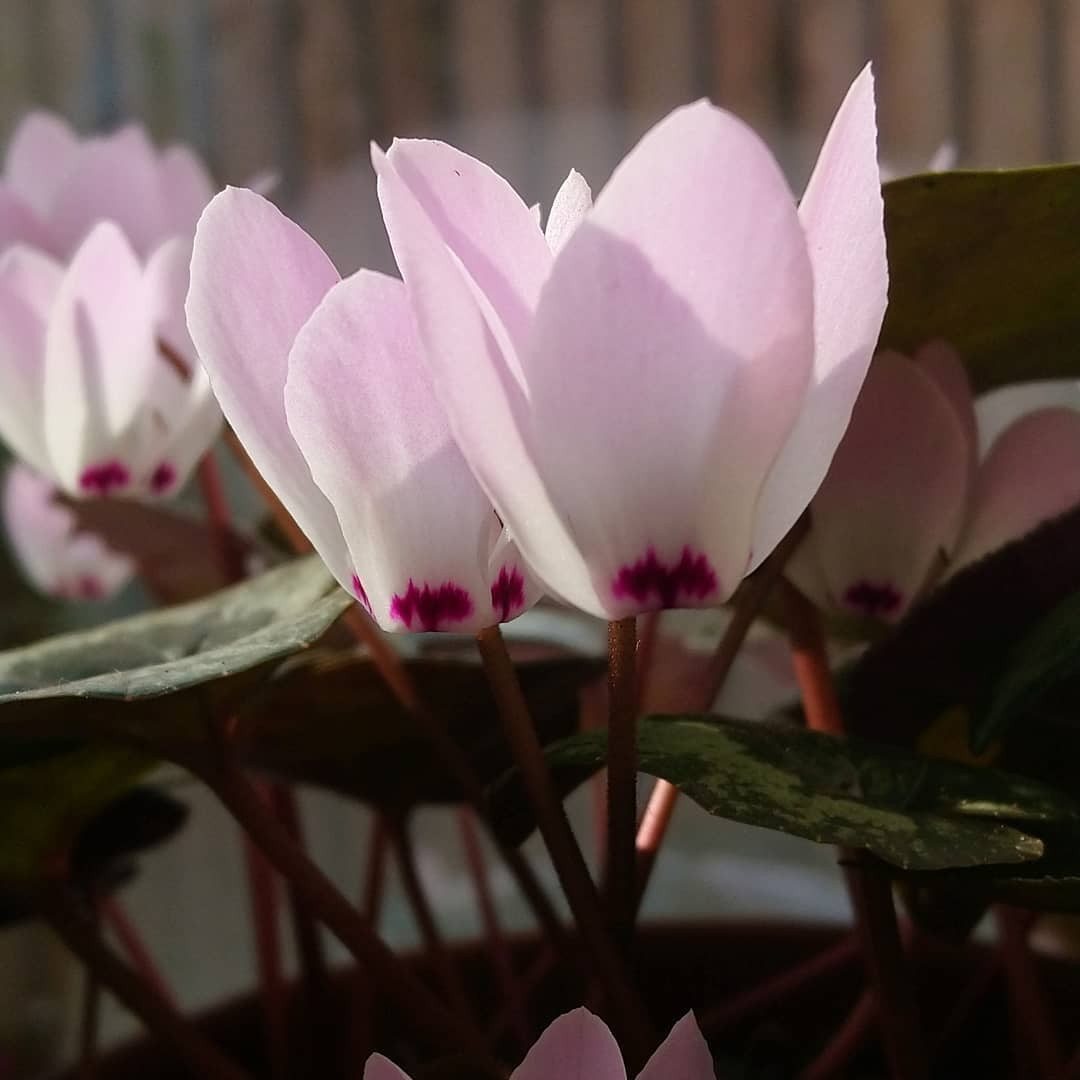
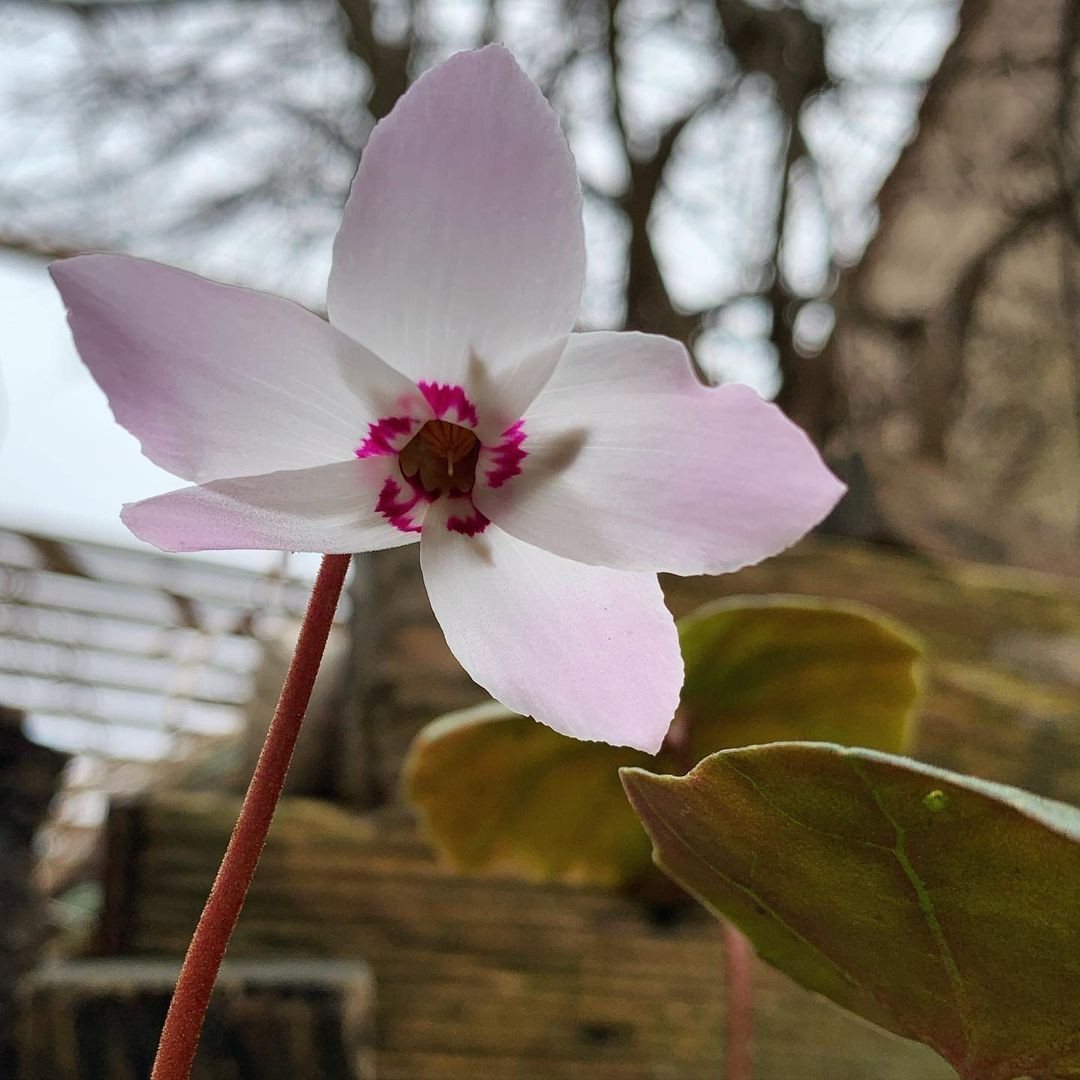

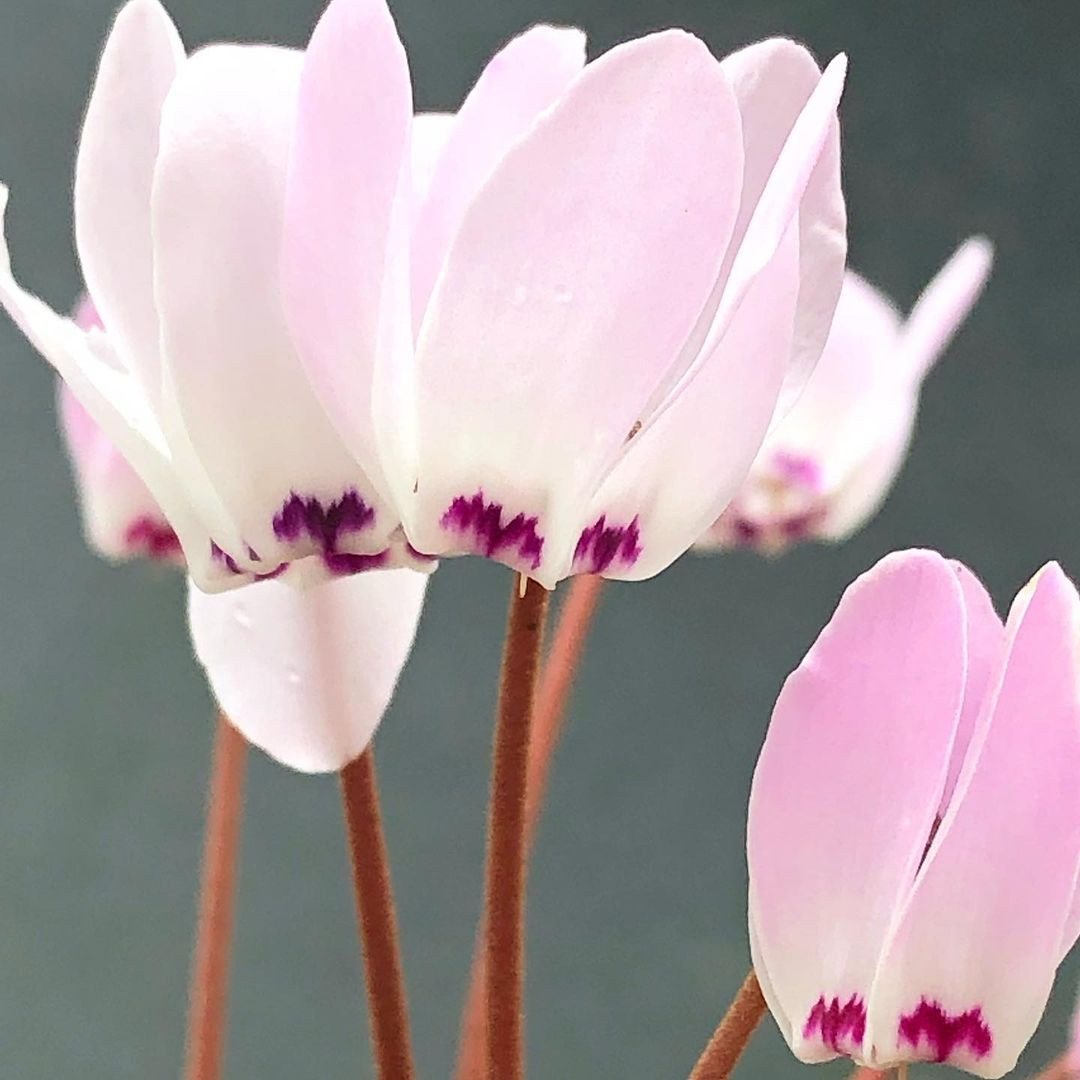
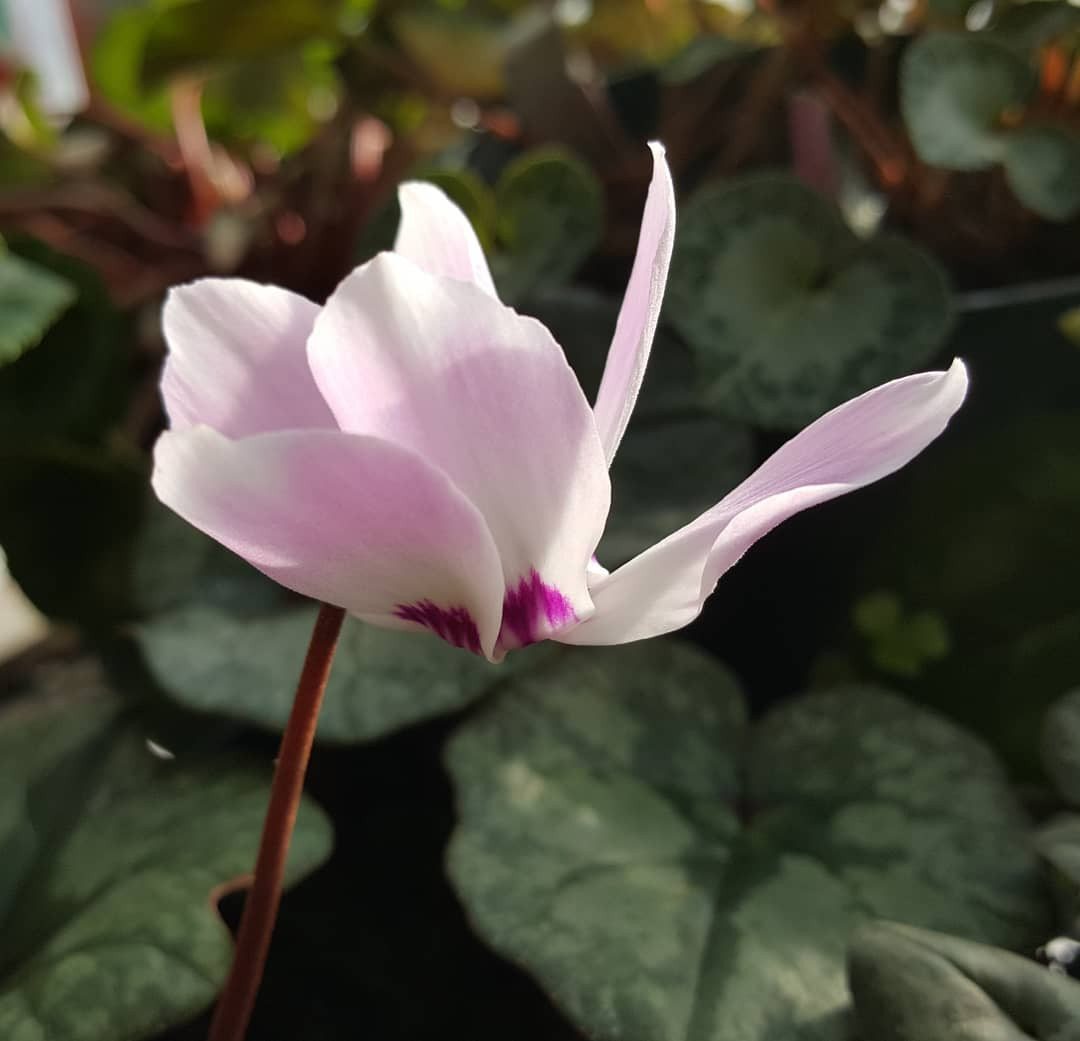





Conditions for growing cyclamen at home
Cyclamen need conditions as similar as possible to their natural environment. Doing this in an apartment is not always feasible. But if you follow all the rules of maintenance, cyclamen will delight you with fragrant flowers every season.
Temperature
The dormant period of cyclamen ends with the onset of cold weather. Growth begins at a temperature of about 10 - 15 degrees. Sudden changes in temperature and drafts should be avoided.
During flowering, the temperature should not be higher than 20 degrees. Otherwise, this will be a signal to go into hibernation. The plant will shed its foliage and buds, and flowering will stop.
In spring or summer, cyclamen can be placed on the balcony. The pot should be hidden from the sun and protected from temperature changes. It must be in the range of 10 – 24 degrees, otherwise the tuber will die.
Lighting
Cyclamen is afraid of bright sunlight directed at it. Burns remain on the leaves in the form of dry brown spots. The plant should be kept in the shady side of the house or specially protected from bright light.
Humidity indicators
Cyclamen needs to be sprayed daily from a spray bottle, as the plant needs high humidity (not lower than 50%).When the first buds appear, spraying is stopped in this way, otherwise the buds will rot.
The pot with cyclamen is placed in a pan of water. The bottom of the pot should not sink into the water. Therefore, pebbles are first placed in the tray.
If there is a battery near the flower, it should be covered with a damp cloth. This will help protect the plant from the heat.
Where to keep
Cyclamen will feel good on a cool windowsill, insulated loggia, balcony or winter garden.
Cyclamen should be protected from sunlight and the pot should be kept in the shade. Prolonged exposure to the sun leads to the death of the plant.
Cyclamen care
Beginners often think that cyclamen is very capricious and difficult to make it bloom. Care is simple, but requires compliance with some nuances.
Priming
Ready-made soil mixtures are sold, but you can prepare the substrate at home. Mix forest humus, peat and sand in equal parts. The pH level of the soil mixture is from 5.5 to 6. If the pH value is exceeded, the plant will be affected by fungal diseases.
Since cyclamen is a tuberous plant, you should not allow water to stagnate in the pot, otherwise the tuber will rot. When planting, the pot is filled a quarter full with drainage. Stones, expanded clay or coarse sand are suitable.
Tara
Cyclamen prefer low and narrow pots. The distance from the tuber to the edge of the pot should be about 3cm.
In a pot that is too wide and high, the plant will not receive the required amount of moisture. The root system will not fully develop in a small container.
Watering
The water should be soft, at a temperature 2 degrees below room temperature. Water should be collected a day before watering and allowed to settle.
During flowering, cyclamen needs frequent watering.The soil in the pot should not dry out, but the water should not stagnate and the plant should not be flooded. On average, cyclamen is watered 1-2 times a week. Cyclamen is well suited to bottom watering. To do this, pour water into a tray and place the pot there. After 1 – 2 hours, the water is poured out.
After flowering, watering is reduced. When the leaves fall and the plant goes dormant, watering becomes even less frequent.
Spraying
Before flowering, cyclamen is sprayed daily with a spray bottle to ensure a certain level of humidity.
After flowering begins, spraying is not done to prevent the flowers from rotting.
Fertilizer
Cyclamen is actively fed after waking up and during growth. Fertilizers should be used once every 2 weeks. The plant responds well to organic fertilizers. You should not give products with a high nitrogen content, as this can cause rotting of the tuber. After flowering begins, feeding stops.
Trimming
After flowering, cyclamen is plucked as the leaves and flowers dry. Water less frequently. It is forbidden to prune the plant when it is blooming. The inflorescences will fall off prematurely.
Transfer
After the plant awakens and leaves appear, the tuber is carefully removed from the pot. Shake off the remaining soil mixture, which is easily separated. If there are rotten roots, cut them off. It is important not to injure the tuber and healthy roots.
A tuber is placed in the center of a pot with drainage and a new substrate. It should rise about half above the soil. Soil is poured along the edges. Fertilizers are not used for about a month after transplantation.
Cyclamens can live several in a pot. The distance between tubers is maintained at least 4 cm.
Bloom
At home, cyclamen can bloom for about 15 years, and about 70 buds will appear on it annually.
During
Flowering occurs after awakening when the temperature drops below 15 degrees. With proper care, the plant will bloom from autumn to spring. As the temperature rises, cyclamen goes into hibernation.
After
After the cyclamen flower has bloomed, it is plucked off near the tuber. This place is sprinkled with charcoal or activated carbon. At the end of flowering, the plant goes into a dormant period: the pedicels dry out, the foliage withers and dries.
Rest period
When flowering ends, the hibernation period begins and lasts 3–5 months. The frequency of watering is gradually reduced. When the leaves completely fall off, water the cyclamen little by little, about once every 2 weeks.
Cyclamen does not need light during hibernation, so the pot is placed in a dark and cool place.
Mistakes in caring for cyclamen
Cyclamen requires compliance with nuances in content. Beginners often don’t know this, so they make mistakes.
| Error in care | How to understand by the appearance of a plant that care is incorrect |
| The air is too humid. The room is very cold. It hasn't been ventilated for a long time. | A grayish coating appears on the leaves and flowers. |
| Watering too often. | Brown-black spots on the tuber and leaf cuttings indicate rotting. The leaves lose their elasticity and wither. |
| Rare watering, dry air. The room is very hot. | The leaves turn yellow when flowering. |
| Watering with unsettled water from a tap. | The leaves turn yellow, the petioles remain green. |
| High humidity, direct sunlight. The room is very hot. | The leaves turn yellow and fall off. |
| Direct sunlight and water on the leaves. | Burns in the form of dry brown spots on the leaves. |
| Little fertilizer, dry air, infrequent watering. | The plant blooms little or not at all. |
| High humidity, little light, cold room. | Flowers hide under leaves. |
By the slightest change in the appearance of the plant, you can immediately understand that a mistake has been made in its care. It needs to be eliminated quickly, otherwise the cyclamen may die.
Reproduction of cyclamen
Cyclamens reproduce in five ways: seeds, babies, tuber division, rosettes and leaves. Even beginners in floriculture can successfully grow cyclamens at home.
All propagation procedures are carried out during the plant's dormant period.
Seeds
Seeds can be bought at a flower shop or collected from house plants. This will require artificial pollination. You can shake the flowers so that the pollen rises and settles again on neighboring ones. After flowering, seed boxes are formed.
It is better to plant cyclamen from mid-winter to the first half of spring:
Preparation of planting material
The seeds are germinated before sowing. A plastic container with a lid is used for this. A thin layer of soil is laid on the bottom, into which the seeds are then placed. The soil is constantly moistened with a spray bottle and not allowed to dry out.
The lid is not tightly covered so that the soil dries out slowly and there is sufficient air flow. This way the seeds will not become moldy or rot.
The room temperature should be about 20 degrees. Then in about a month the seeds will germinate.
Preparing the soil and pot
Soil mixture for cyclamen can be purchased at a flower shop or prepared independently. To do this, take humus, peat and sand in equal parts. Germinated seeds are planted in a special box. The seedlings are very fragile, so all manipulations with them must be carried out carefully.
Transplanting into pots
After the appearance of small nodules and 2 - 3 leaves, the seedlings are picked and transplanted into separate small pots with soil mixture for cyclamen. Plants begin to be fed a week after transplantation. Fertilizers with potassium and complex fertilizers are used.
Children
The mother tuber produces babies - smaller nodules. They are separated when transplanting a large tuber, so as not to injure it again, and planted in a prepared container. You need to water regularly, but not abundantly. After a week, the first leaves appear and you can begin fertilizing the soil.
Tubers
The propagation procedure by tubers is carried out strictly during the dormant period. Preferably closer to the end. Choose large overgrown bulbs.
To prevent cyclamen from dying after dividing the tuber, the following conditions must be observed:
- The tuber is dug up and dried.
- The tuber is cut into pieces with a sharp stationery knife.
- A bud and roots should remain on each part.
- The cut areas are treated with ash or coal and dried.
- Each part is placed in a pot with soil.
- Watering is done along the edge of the pot or through a tray.
The temperature in the room where the plant is located should be 14 - 16 degrees. After the first shoots appear, fertilizing begins.
Rosettes
The mother tuber of cyclamen has buds. Sometimes long shoots appear from them. They are called rosettes or horns.
This shoot is torn from the tuber and transplanted into prepared moist soil. The damaged area on the tuber should not rot; it should be sprinkled with coal.
The shoot in a separate pot is loosely covered with a jar or plastic bottle.After 2 - 3 weeks, roots should appear on the shoot, then the covering is removed and the plant is cared for as usual.
Leaf
This is a difficult method of propagation, because the leaves often rot and die rather than take root. Soil is used for rooting, not water. This type of propagation is only suitable for European cyclamen.
The leaf is torn off with a small piece of tuber. At the end of the petiole, small thread-like shoots remain, which should allow the leaf to take root in the soil. The leaf is covered loosely with a jar or plastic bottle. After rooting, the greenhouse is removed and the plant is cared for as usual.
Major pests
The reasons for the appearance of pests on cyclamen are improper care and maintenance conditions.
Shchitovka
A tiny insect measuring 2–5 mm with a hard shell. In appearance it resembles a turtle. The larvae actively move, hide in the axils of leaves, and disguise themselves as spots. Female scale insects do not move, but males can fly from place to place.
Scale insects feed on plant juices, sucking microelements from it for development.
Cyclamen is affected by scale insects due to improper watering, lighting and air temperature (too cold or hot). Pests feel at ease on a weakened plant.
Signs of infection:
- sticky coating on leaves;
- leaves dry out and turn yellow;
- young shoots do not grow;
- flowers and buds fall.
Fighting scale insects:
- Treat with soap solution or insecticides (“Aktara” or “Bankol”).
- Cover with film for 1 hour.
- Repeat the manipulations every 3 to 4 days for 2 weeks.
- The affected plant is isolated from others.
At the first sign of infection, the entire plant must be carefully inspected.
Mealybug
The mealybug or hairy louse has an oval body up to 4 mm in length, covered with a white powdery coating. The larvae are usually yellow. They attach themselves to a specific location and feed on the sap of the plant. The cause of the damage is dry air in the room.
Signs of infection:
- leaves turn yellow and fall off;
- white lumps appear on the plant;
- buds and flowers are deformed.
Fighting mealybugs:
- Treatment with soap solution or garlic infusion.
- Treatment with insecticides (“Aktara”, “Aktellik”, “Phosfamide”).
The fight is complicated by the fact that pests can also be found in the soil. Cyclamen treatment must be done several times to destroy all insects.
Thrips
Thrips are small insects of black, gray or brown color. The length of their fusiform body is about 2 mm.
Thrips quickly spread throughout the above-ground part of the cyclamen. Infection occurs due to too hot and dry air. Insects are very persistent and hardy, which makes fighting them much more difficult.
Signs of infection:
- punctures, dots, and light spots appear on the leaves;
- the plant becomes discolored;
- the leaves become grayish-brown, their edges curl;
- buds and flowers dry out and fall off.
Thrips control:
- Isolate the plant.
- Dig up the tuber and wash it in potassium permanganate.
- Replant into new soil.
- Treat with insecticides (Aktara, Karbofos, Fitoverm) once a week.
An effective control method is spraying with garlic solution, since thrips cannot tolerate its smell.
Spider mite
Spider mites are microscopic insects about 1 mm in size. The color is green in summer, red in autumn. Ticks like to settle on the underside of cyclamen leaves.The reason for the appearance is dry air and too high a temperature.
Signs of infection:
- the plant is entangled in small cobwebs;
- leaves turn brown and dry out;
- growth slows down.
Fighting spider mites:
- Quarantine the plant.
- Treatment with insecticides (“Aktellik”, “Fitoverm”) 2 times for 2 weeks.
- Treatment with soap solution.
Calendula decoctions are used to combat spider mites. onion peels, dandelion, etc.
Cyclamen mite
An insect 1–3 mm in size with a yellowish body. The reasons for its appearance are dry air and too high room temperature.
Signs of infection:
- dusty coating on the plant;
- the edges of the leaves are deformed;
- buds and flowers fall;
- stems curl.
Fighting cyclamen mites:
- Remove affected parts of the plant.
- Treat with insecticides (Fitoverm, Iskra, Neoron).
Folk remedies are suitable: a decoction of onion peels, orange peels, garlic and others.
Aphid
Aphids often enter through an open window from the street. The size of the body is 1.4 – 2.5 mm. The color can be different: black, gray, orange or green. Aphids do not have wings. Insects drink the sap of the plant and gather on its most tender parts: young leaves, buds or shoots.
Signs of infection:
- cyclamen growth stops;
- leaves curl and turn yellow;
- buds and flowers dry up and fall off;
- a sticky coating appears.
Fighting aphids:
- Place the plant in quarantine.
- Wash the cyclamen with warm water and wipe each leaf with soapy water.
- Treat with insecticides (Aktara, Confidor, Agravertin) or decoctions of onion peels, nettles, orange peels, pine needles, etc.
It is important to notice aphids as early as possible, then you can deal with them much faster.
Grape weevil
Weevils are active at night and hide during the day, making them difficult to detect. They eat the roots and buds of the plant. The affected plant often dies. Pests multiply quickly and infect neighboring specimens.
Signs of damage are difficult to detect immediately, because in cyclamen the weevil eats the tuber. If you pull the affected plant by the aerial part, it will easily come off with the upper part of the tuber.
It is useless to fight the weevil, since the plant is already doomed to die.
To prevent cyclamen from being affected by the weevil, you need to follow the watering rules, remove dead leaves in a timely manner, and treat the pallets before use.
Frequent cyclamen diseases
Cyclamen sometimes get sick. It is important to quickly recognize the symptoms and begin treatment so that the plant does not die.
Fusarium wilt
Signs of the disease: the leaves begin to turn yellow, the yellowness spreads, the foliage withers and dies. This gradually happens to the entire plant.
The disease is caused by a fungus. To stop the disease, you need to cut off all the yellow leaves. Then the cyclamen is watered with a fungicide.
Wet rot
Signs of the disease: smell of rot, rapid wilting of the plant.
The disease is caused by the use of contaminated water. It is transmitted from one flower to another, so sick specimens are isolated. If the tuber is affected, death is almost inevitable. Rotten areas are cleaned and treated with fungicide. After this, the tuber is transplanted into new soil.
Gray rot
Signs of the disease: a gray coating appears on the leaves, they begin to turn yellow.
The reason is too much humidity and low temperature.The affected parts are removed from the plant and watered with a fungicide.
Root rot
Signs of the disease: dark spots appear on the tuber, the foliage turns yellow and withers.
The disease is caused by various fungi. It occurs due to poorly selected soil. It may be too late to save the plant. Young specimens usually die. The tuber of an adult plant is cleaned, treated with a fungicide and replanted.
Anthracnose
Signs of the disease: flower stalks do not develop, their upper part dries out, flowering does not begin, the foliage dries and curls.
The disease is caused by a fungus that develops at high humidity and temperature. It is necessary to remove the affected parts and treat them with a fungicide.
Sooty fungus
Signs of the disease: black plaque, which is a consequence of aphids. This coating is not dangerous, but it blocks the light. The leaves dry out and fall off under the coating. You need to wash the plant with clean warm water and water it with fungicide.
Problems during cultivation
Cyclamen reacts painfully to any changes in content, so gardeners may encounter certain problems. The flower immediately reports pests and diseases by changing its appearance.
Spots on leaves
Brown spots on the leaves can be a signal of excess moisture. Overwatering leads to rotting of the tuber, which is reflected in the foliage. The rotten tuber is cleaned, treated with a fungicide and transplanted into new soil.
Sunlight causes burns in the form of spots on the leaves. This means the plant needs to be protected from the sun.
Spots on the leaves indicate diseases or pest activity.
Spots on flowers
Spots on flowers indicate thrips infestation. Cyclamen is quarantined and treated with insecticides.
The cause may be a disease caused by fungi. Then the flower needs to be treated as soon as possible or destroyed if treatment is useless.
The leaves are turning yellow
This usually happens when the plant has already flowered and goes dormant. If the leaves turn yellow during flowering, there may be the following reasons:
- cramped pot;
- little moisture and dry air;
- lack of nutrition;
- room temperature is too high;
- exposure to sunlight;
- presence of pests;
- fungal or bacterial infection.
When entering the dormant period, yellowing is normal. In other cases, care and maintenance are adjusted or cyclamen is treated.
Leaves wither
The reasons for this problem may be the following: a cramped pot, insufficient feeding, pest damage or disease (gray rot, fusarium).
To avoid disease, you need to periodically water the plant with a solution of potassium permanganate, avoid excess nitrogen and water in the soil, and also follow the rules of care.
Leaves are drying
The reason is dry air and unventilated rooms. The plant is provided with the necessary air humidity. The room where the cyclamen is located is regularly ventilated, avoiding drafts.
Drying leaves may be the result of pest activity.
The leaves are curling
The most common cause of rapid leaf curling in cyclamen is mite infestation. The plant must be isolated and treated with insecticide.
The cause may be improper care: too low or high temperature, exposure to sunlight, dry air.
The leaves are falling
Cyclamen sheds its leaves before going into dormancy. If the process happens gradually, there is nothing to worry about.When a plant becomes bare in just a few days, this may be the result of pest damage (fungi, mites, viruses) or improper care (exposure to sunlight, insufficient feeding, incorrect watering regime).
The flower sheds its buds
If a flower sheds its buds, then the conditions are not suitable for flowering: exposure to sunlight, too high a room temperature, inappropriate watering regime. The cause may be pest damage or disease.
Spots on tubers and leaf petioles
Spots on tubers and leaf petioles indicate rotting of the plant. If the process is started, it may be impossible to save the plant. The rotten tuber needs to be cleaned, treated with a fungicide and replanted.
The cause of rotting is frequent watering or fungal diseases.
Flowers hiding under leaves
Flowers hide under the leaves if the room temperature is too low and the humidity is very high. Cyclamen should be moved to a warmer place and properly cared for.
Plaque on buds and flowers
Plaque indicates the presence of pests (thrips) or fungal diseases. Cyclamen must be treated urgently.
Scanty flowering
Poor flowering is caused by insufficient feeding of the plant. Often young specimens cannot support a large number of flowers. After leaving the dormant period, cyclamen must be fed so that flowering is abundant.
No flowering
During the flowering period, cyclamens need to maintain certain conditions: temperature, humidity, lighting, watering. Lack of flowering is usually a consequence of improper care and maintenance.
Useful properties of cyclamen
Cyclamen tuber juice has antimicrobial and anti-inflammatory properties.
There is an opinion that juice normalizes hormonal levels. In men, it enhances potency. Helps women with infertility and irregular menstrual cycles.
The juice has a wound healing and hemostatic effect. It can destroy pathogenic microflora of the gastrointestinal tract, mucous membranes of the nose and throat.
Is there any harm
Cyclamen tubers contain poison, so their juice is used with caution. If there are small children or animals at home, it is better to avoid breeding cyclamens. All manipulations with the plant should be carried out using rubber gloves.
Cyclamen juice can cause allergies, nausea, vomiting, confusion, headaches, convulsions, bronchospasm, and pulmonary edema.
Signs and superstitions
Most signs and superstitions have a positive connotation.
Family happiness
There is a belief that blooming cyclamen absorbs negative energy and balances the atmosphere at home. Relationships between different generations of the family become easier, conflicts become a thing of the past.
To do this, the cyclamen must bloom. A plant with red flowers is especially helpful in family matters.
Wealth
A plant with white flowers helps to obtain material well-being. To do this, you need to put a white petal in your wallet or drop a little aromatic cyclamen essential oil.
For men
Cyclamen helps men gain self-confidence. Representatives of the stronger half of humanity begin to feel that they themselves create their own reality and the opinions of others influence them much less. Depression and dark thoughts quickly recede.
For women
Cyclamen is ideal for women and girls.It helps to regain femininity, softness and the attention of men. The feelings that faded between the spouses will flare up with passion again.
If a couple cannot get pregnant for a long time, then a miracle of conception must certainly occur next to cyclamen.
Reviews from flower growers
Cyclamen really evokes positive emotions and pleases its owners with long flowering.
It seems to me that minimal care is needed. It blooms for a long time. It's not cold in my apartment, but cyclamen still feels good. I recently tried to grow Persian cyclamen from seeds. It took a long time for the shoots to appear, but all the seeds sprouted.
When we returned to work, I saw that my beautiful flower had been flooded to death! I got upset and took him back to my office. The cleaning lady found him here too. My pet had no chance to survive.
Later I bought the same one for myself and took it straight home out of harm’s way.
Oddly enough, my cyclamen blooms whenever it wants: in spring, summer, autumn. Just don't put it in direct sun. I water it moderately, trying not to overdry. Under any unfavorable conditions, cyclamen sheds its leaves and goes into hibernation. The tuber can live for a long time without water.
It’s been blooming like this for me for 10 months without a rest break. I try to protect the cyclamen from the sun by watering it through a tray. Every day in summer, less often in winter. I can’t replant it from a store pot, because it blooms and blooms.
If the cyclamen is provided with all the conditions for existence and the necessary care, it will bloom regularly. The flower reacts sharply to unsuitable conditions or diseases. But even a beginner can cope with the maintenance of cyclamen if he knows the reasons for changes in the appearance of the plant.


